2025 marked the "first year" of stablecoin cross-border payments, with new announcements released almost daily and landmark regulatory documents officially propelling stablecoins into traditional financial markets. "We're reaching a 'tipping point,' where everyone realizes this is a fundamentally new payment technology, with real businesses and practical use cases emerging. This isn't just some cryptocurrency craze, but real applications," said Chris Harmse, co-founder of BVNK, an enterprise-grade stablecoin infrastructure.
But enthusiasm also brings bubbles. Triple-A founder Eric Barbier warned: "On LinkedIn and at the conference, stablecoins seem to be regarded as a panacea, as if they can end world hunger, poverty, and cure cancer tomorrow - this is obviously too much."
With the rapid advancement of stablecoin and blockchain technologies, the financial payments landscape is shifting rapidly, and the positioning of business partnerships is also changing accordingly. FXC Intelligence's 100-page report on the frontline stablecoin payments market, "The State of Stablecoin in Cross Board Payments" (The 2025 Industry Primer), is a valuable practical guide for stablecoin payments. It integrates FXC Intelligence's cross-border payments data, extensive research, and the perspectives of 14 industry experts.
1. Stablecoin Ecosystem
Although stablecoins are still an emerging technology, they have made the leap from fringe experiments to mainstream vision in just a few years.
"The changes in the past 18 months have been particularly dramatic," said Chris Mason, co-founder and CEO of B2B stablecoin payment company Orbital. "The first to embrace stablecoins are often high-risk, high-growth emerging industry players; now, the second wave has arrived - payment service providers and traditional banks are collectively awakening."
Iana Dimitrova, CEO of OpenPayd (a provider of fiat financial infrastructure), added: “The current explosion is not an overnight success, but the result of more than 15 years of trial and error and iteration. The market has finally reached a consensus on the practical value of stablecoins, and the technology itself has reached a critical point for large-scale commercial use.”
The industry's roots lie in the world of cryptocurrency trading: that's where it all began, and soon after, we began exploring new use cases for stablecoins.
—Nikhil Chandhok, Chief Product and Technology Officer, Circle
1.1 A brief history of stablecoins
Stablecoins originated from the launch of cryptocurrencies in 2008: a tokenized, decentralized and immutable digital currency that runs on a blockchain based on a distributed ledger. Stablecoins were first born with Bitcoin, which was introduced to the world in October 2008 by an anonymous researcher (alias Satoshi Nakamoto) who published a paper titled "Bitcoin: A Peer-to-Peer Electronic Cash System".
From its inception, Bitcoin was positioned as a method for online payments that eliminated the need for financial intermediaries. Despite some limited experimentation with payments by early adopters, it gained widespread popularity among internet natives and technologists speculating in cryptocurrencies. As interest in Bitcoin grew over the following years, some began experimenting with using the underlying technology for cross-border payments. However, due to its volatile prices, lack of regulation, and association with black market activity, many struggled to consider it a payment technology.
With the advent of stablecoins, this has changed: stablecoins represent a pivotal moment in the evolution of blockchain technology, as we are currently witnessing its journey from the days of the early internet into the beginnings of the modern digital age.
Stablecoins are like the birth of Napster, the P2P music file sharing platform.
—Teymour Farman-Farmaian, co-founder and CEO of Higlobe, a company that provides US dollar receiving accounts to businesses in emerging markets
The first digital currency issued as a stablecoin was BitUSD, which introduced the concept of a 1:1 peg between a cryptocurrency and a fiat currency (in this case, the U.S. dollar) in 2014. However, since it was backed by cryptocurrency, it did not fully meet the definition of a stablecoin as we understand it today.
Other companies quickly followed suit, but it was Tether that really introduced the concept of fiat currency reserves, launching USDT later that year. Over the next few years, USDT grew in popularity and attention, but also faced questions about transparency and regulation, and Tether eventually took major steps to address these issues.
In the early days of stablecoin development, developers were gradually understanding the meaning of stablecoins and how to use them. In 2018, more regulated stablecoins began to emerge, with Paxos launching what is now the Pax Dollar (USDP) and Circle launching USD Coin (USDC) through its alliance with Coinbase. These regulated, US-based stablecoins began to gain popularity, attracting interest not only within the cryptocurrency sector but also within mainstream finance. Simultaneously, financial infrastructure players built on stablecoins also began to emerge, including Fireblocks in 2018 and BVNK in 2021.
However, in 2022 and early 2023, stablecoins faced a significant crisis of confidence, triggered by several events that shocked the industry. First, the sudden collapse of TerraUSD (UST), an unconventional algorithmic stablecoin backed not by cash reserves but by an algorithm. After its value plummeted from its $1 peg, panic trading triggered a "death spiral" that also caused the value of several other stablecoins to briefly fluctuate on major markets. Although UST is not a traditional stablecoin, and Circle, Paxos, and others have attempted to distance themselves from algorithmic stablecoins, the damage to the industry's reputation remains significant.
While many participants claimed their reserves protected them from the aforementioned issues, giving them comfort, the collapse of Silicon Valley Bank (SVB) in early 2023 raised new questions. At the time of the collapse, Circle held approximately $3.3 billion in reserves with SVB, and there was initial uncertainty about whether these deposits would be guaranteed. This triggered a so-called "shadow run" as holders worried they would not be able to redeem the stablecoin at a 1:1 ratio, causing its trading value to plummet to an all-time low. While the US government ultimately did guarantee SVB's reserves, and Circle never faced a real risk of being unable to redeem its USDC holdings, the reputational damage was even more severe, particularly for institutions that rely on a stablecoin backed by US reserves.
During this crisis, USDT adoption overseas continued to climb, while the number of USDC tokens in circulation in the United States steadily declined throughout 2023. As a result, a streamlined, more robust version of the industry began to slowly emerge from the ashes of this crisis. Driven by real demand in key channels and verticals, infrastructure companies continued to increase transaction volume and adoption and improve their products accordingly, while other companies launched products focused on the true utility of their technology. In the second half of 2023, PayPal launched PayPal USD (PYUSD), casting a crucial vote of confidence in the industry, while other companies focused on educating those who were unsure about stablecoins, establishing a regulatory framework, and increasing adoption. "The education work was really hard, but people are really starting to understand it," said Mason, CEO of Orbital.
Since the beginning of 2024, the number of USDC tokens in circulation has climbed again, and the number of newly issued tokens focused on payments has continued to grow. More recently, Trump’s return to the presidency has also increased institutional support for the technology, and regulatory measures such as the GENIUS Act have also been introduced.
Since the change in US government, major financial institutions have been looking to firms like ours for help understanding where and with whom they can work to conduct stablecoin business in a compliant manner.
—Guillaume C, EMEA Business Development Director, Paxos, a stablecoin issuer
Today, with adoption rates climbing rapidly and interest from the cross-border payments industry evident, there is further room for growth, but the underlying principles of stablecoins remain largely the same as the premise originally laid out by Satoshi Nakamoto in his Bitcoin paper.
We are solving the cash problem on the Internet.
—Nikhil Chandhok, Chief Product and Technology Officer, Circle

1.2 Cross-border payment sector shows growing interest in stablecoins
As stablecoin technology has taken off, its use cases in cross-border payments have also increased. As Paxos’ Kendall explained, while stablecoin usage is still primarily focused on “crypto-native activities,” interest in the space is growing, driven in large part by the most fundamental needs of end users.
The development of stablecoins began in the trading and investment fields, and then gradually gained a foothold in the cross-border payment field during 2022 and 2023.
—Michael Shaulov, Co-founder & CEO, Fireblocks, a digital asset infrastructure provider
This experience is shared by many companies in the space, including Conduit, which specializes in B2B payments. However, in the past year or two, things have begun to change.
Initially, it was mainly businesses that were crypto-native payment companies, helping their end businesses move money between these corridors more efficiently. Today, I'm seeing a major shift, with many companies, especially large multinationals, starting to get involved in this space. They want to understand how stablecoins can be used, especially in difficult regions like Africa, Latin America, and Asia.
—Kirill Gertman, Founder and CEO of Conduit, a B2B stablecoin payments company
This has also prompted some cross-border payment infrastructure providers that previously focused on fiat currencies to enter the market, such as OpenPayd, which added stablecoin capabilities earlier this year.
“For us, this evolution was completely natural, as we already had existing clients who were using us for cross-border fiat payments coming to us and saying, ‘We already accept stablecoins through other providers. Can you integrate these assets into your platform?’” said Dimitrova of OpenPayd. “We’ve been getting these requests over and over again over the past 18 months, and we realized that if we didn’t provide this interoperability, we wouldn’t be able to meet the growing needs of these clients.”
While these requests primarily come from businesses with global trade needs, stablecoin adoption is also growing in other areas of cross-border payments, including MoneyGram, which has begun offering stablecoin payment functionality. In 2022, MoneyGram began sending remittances in USDC and has since expanded its capabilities in this area, including launching MoneyGram Ramps, a deposit and withdrawal solution for white-label digital wallets, and addressing its own cross-border fund management needs.
MoneyGram is a fintech company with a global digital and cash network. Stablecoins will play a very important role in MoneyGram's future. It helps every part of our business, from the B2B backend to the B2C service delivery method to how we serve consumers.
—Anthony Soohoo, Chairman and CEO, MoneyGram
Despite their small market share, stablecoins are seeing a significant increase in interest. In the first half of 2025, the number of press releases related to stablecoins and payments increased by 186% year-over-year, outpacing the overall growth in stablecoin press releases. The number of press releases related to cross-border payments and stablecoins surged by over 1,000%. And that's just for companies publicly launching stablecoin solutions.
According to BVNK Harmse, the vast majority of companies in the payments industry see the opportunities presented by the technology, even if they haven’t discussed it publicly. “I think 95% of companies see it,” he said. “From the conversations we’re having and potential collaborations, there are indeed a lot of traditional payment companies that are actively investing, even some companies that you wouldn’t think would invest.”
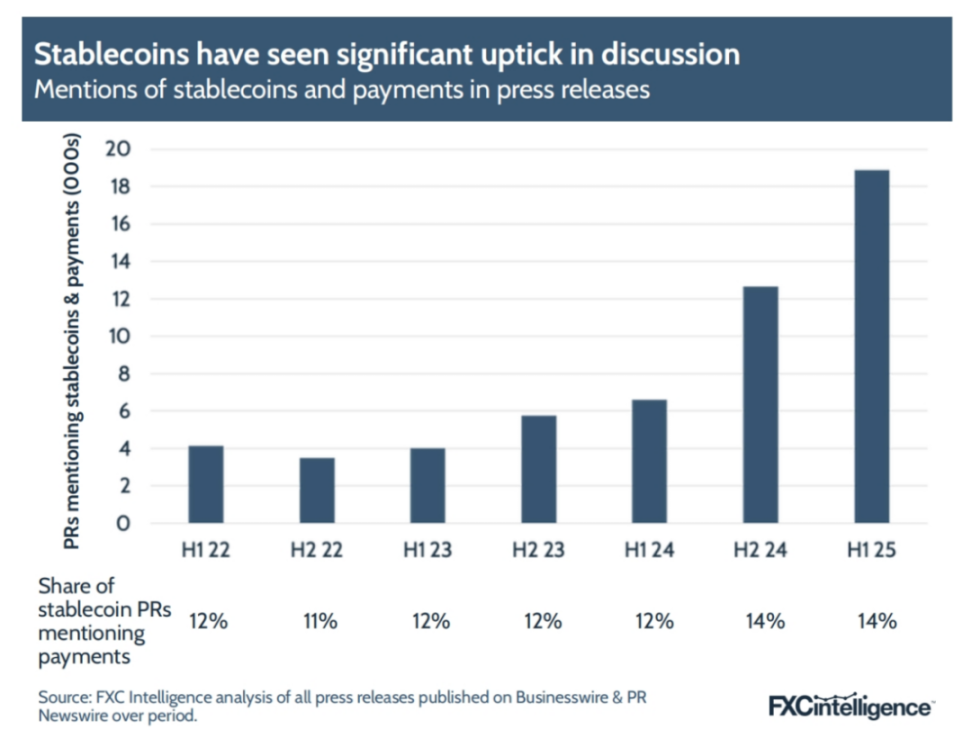
1.3 Stablecoin Payment Investment Surges
In addition to the growing interest from established companies, capital is also increasing. Despite the cooling of the overall venture capital environment, the stablecoin sector continues to attract capital, with a large number of projects officially announcing financing in the past year.
“Investors are looking at return potential first and foremost,” said Gertman of Conduit, which raised $36 million in Series A funding in May. “When they saw how quickly our revenue was growing and how quickly our volume was climbing, they realized we had a chance to capture a much larger market than we have today.”
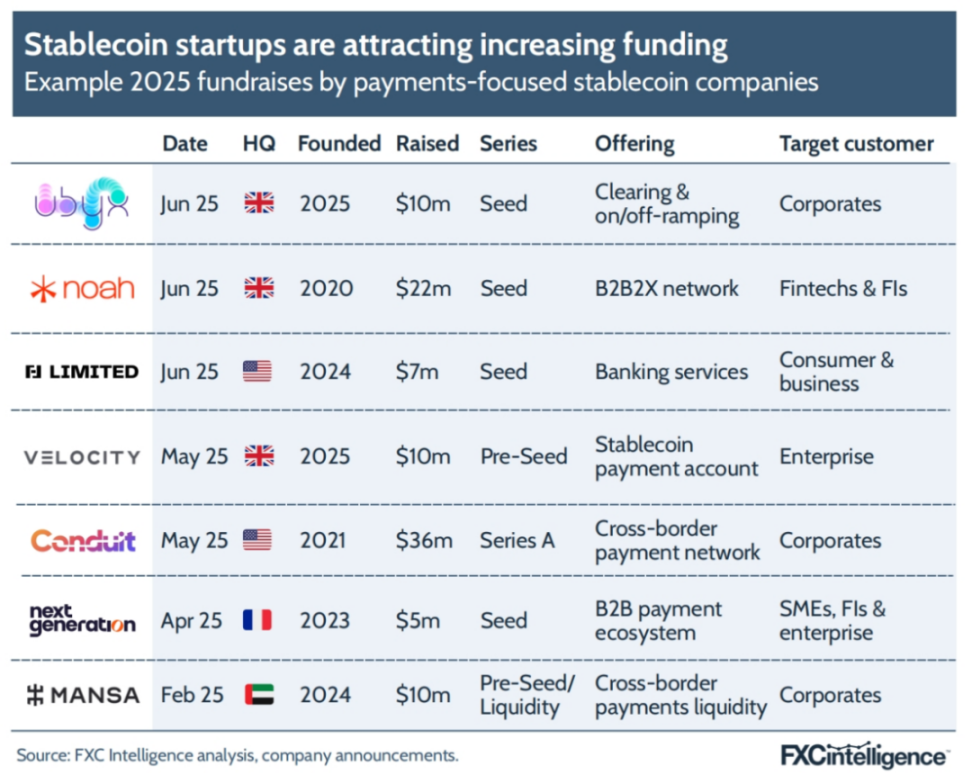
At the same time, a series of mergers and acquisitions are also accelerating: traditional giants hope to quickly supplement their capabilities in this field through acquisitions. Despite the frequent actions, Stripe's acquisition of the stablecoin infrastructure company Bridge, announced in 2024 and completed in early 2025, is still widely regarded as a catalyst for the entire industry to "take this technology seriously."
“It forced everyone to re-evaluate the market,” said BVNK’s Harmse. “We were already in talks with several of the world’s top payment companies, and this acquisition has accelerated the pace of those conversations several times.”
Airwallex co-founder and CEO Jack Zhang believes Stripe's move has deeper implications: "Stripe is a master of storytelling. They used this acquisition to create a superb brand story, thrusting stablecoins into the spotlight. It could even be argued that it fueled the current stablecoin craze."
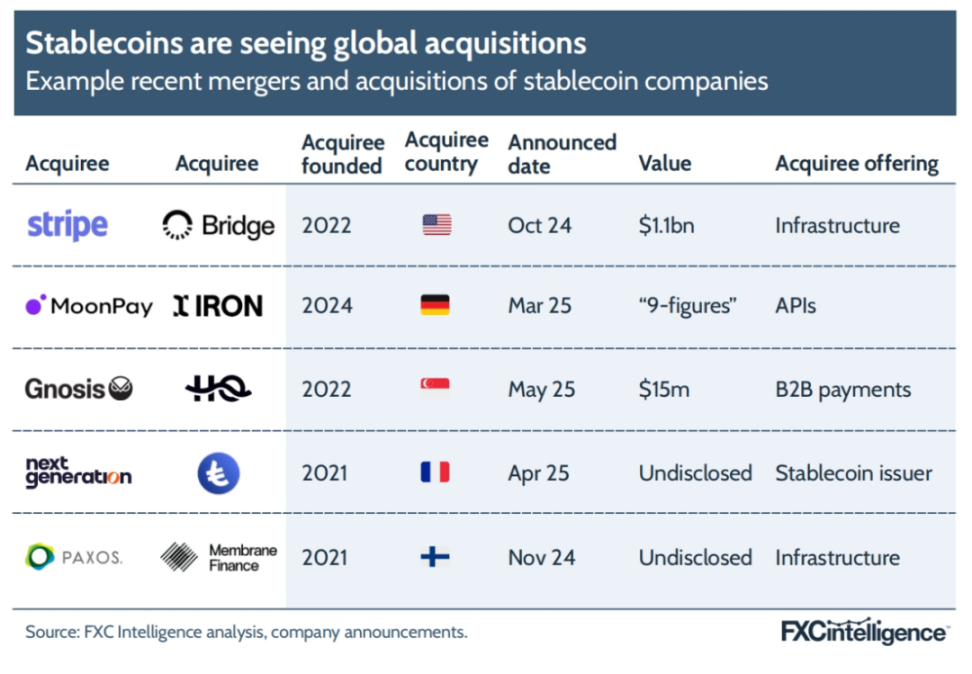
2. Current status of cross-border payments of stablecoins
The underlying logic of stablecoin payments is simple: in theory, they outperform existing mainstream solutions in multiple dimensions (speed, reliability, and transparency). While costs (deposit and withdrawal acceptance) still need to be optimized, this depends on further improvements in liquidity.
However, the reality is not all rosy. Despite a growing number of successful cases, stablecoin payments still face numerous complexities in their implementation. The overall scale of payment scenarios is relatively small, leaving some capabilities still in the verification phase.
The key to truly understanding the potential of stablecoins is to return to the user perspective - customers don’t care about the word "stablecoin" at all.
Users don’t care what currency you use. They care about three things: security, speed, and the best price—the same things that haven’t changed in 3,000 years.
——Farman-Farmaian, Higlobe
Therefore, the true value of stablecoins lies in scenarios where they can “practically and reliably improve the existing payment experience.” At least for now, such improvements are most concentrated in emerging markets.
“As long as there is a cross-border link in payments, stablecoins will shine.”
— Chris Harmse, Co-founder & Chief Commercial Officer of BVNK
2.1 Emerging Markets: The Main Battlefield for Stablecoins
Whether it is the payment infrastructure companies that bet on stablecoins early on or the new players who have entered the market recently, their views are surprisingly consistent: in countries where the traditional payment system is weak, stablecoins are not only "the best solution now", but also the driving force behind the birth of the entire "stablecoin cross-border payment" track.
“Global e-commerce platforms have long felt the pain points of collecting, lending and retaining payments in countries with poor infrastructure,” said Dimitrova of OpenPayd. “They have been quietly looking for alternatives in the background, but traditional financial institutions are only now realizing this.”
The pain points include not only those who want to move funds "cheaply and quickly", but also: 1) companies that have difficulty accessing internationally available payment tools; 2) institutions and individuals who are deeply trapped in the quagmire of local currency fluctuations.
Some agent merchants cannot even open a bank account, so we give them a B2B wallet and use stablecoins for settlement.
—Luke Tuttle, Chief Product and Technology Officer, MoneyGram
However, demand in emerging markets is not monolithic. The explosion of one scenario often spawns more, cascading demand. What is certain is that large amounts of cross-border capital flows through unpopular channels have created a substantial and expanding market. Stablecoin players are flocking to the market, and their customer profiles are becoming increasingly sophisticated.
“We’re working with an airline that needs to collect payments in multiple countries across Africa and remit them back to their headquarters in Europe,” says Conduit’s Gertman. “As long as they can figure out the use case quickly, they’ll try it out.”
Not only are clients being upgraded, but local partners are also becoming increasingly professional. Orbital's Mason noted, "We already have local partners for deposits and withdrawals in 80-90 currencies. Amid the stablecoin craze, partners in emerging markets are rapidly becoming more specialized."
2.2 How Stablecoin Payments Work: The Stablecoin Sandwich and Technical Architecture
In the real payment process, stablecoins are just one layer in the entire technology stack. The entire architecture can be imagined as a "sandwich" - stablecoins are sandwiched in the middle, with multiple layers of capabilities at the top and bottom to complete cross-border value transfer.
On the custody layer, stablecoins themselves circulate between different wallets, which run on the blockchain network. The blockchain is the digital ledger that forms the underlying "rails."
Above the custody layer is the on/off ramp layer, which truly enables users to seamlessly convert between fiat currencies and stablecoins. This layer is the core of solutions such as foreign exchange, fiat deposits, and withdrawals. While implementation varies significantly, it often requires connections to local banks. Liquidity pools are also required to ensure users can readily convert stablecoins into their desired fiat currencies.
Compliance layer KYC/AML tools are almost identical to fiat currency products, and sometimes existing systems are directly reused.
The application layer (Application Layer) encapsulates all four layers of the above, including apps, web pages, APIs, and embedded interfaces that users ultimately see, making the "cross-border delivery in seconds" experience just a click away.
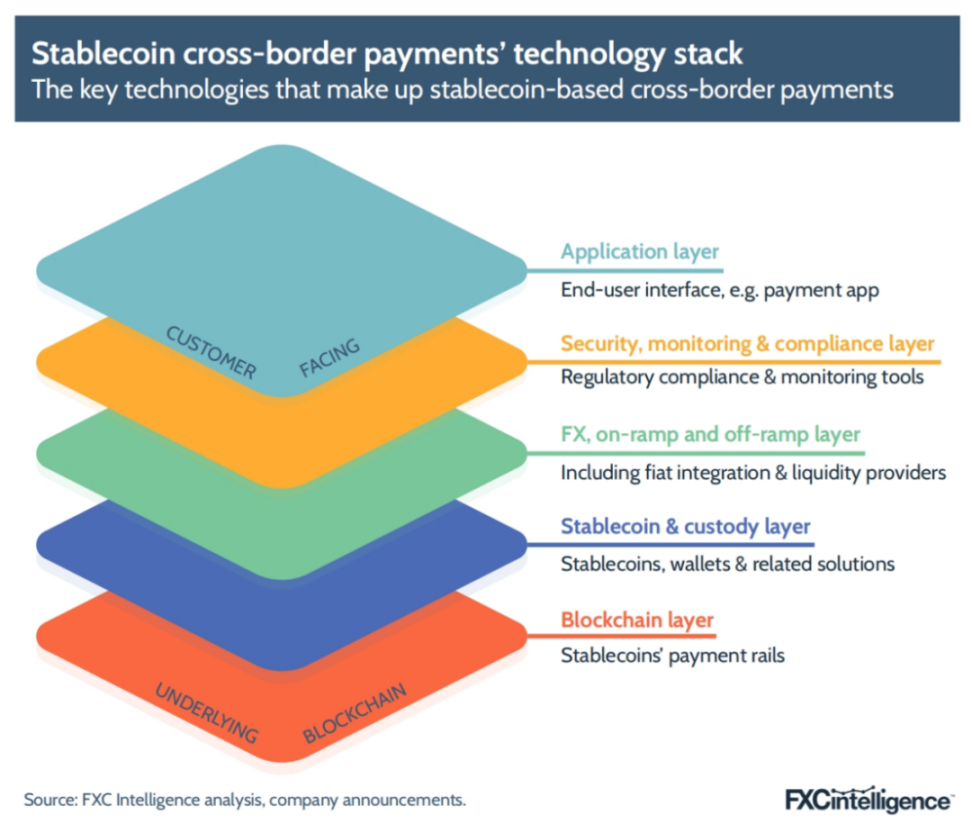
2.3 Stablecoin Sandwich Model
Despite variations in details, the current standard practice for cross-border stablecoin payments is often referred to as a “stablecoin sandwich,” a term first coined in 2021 by Ran Goldi, Senior Vice President of Payments and Networking at Fireblocks.
In the traditional correspondent banking model, cross-border payments must go through a chain of local banks, international banks, and local receiving banks, with currency exchange completed along the way. The "stablecoin sandwich" simplifies the process to:
- First, convert the sending fiat currency into stable currency.
- Then complete the international transfer through blockchain,
- Finally, the stablecoin is exchanged for the target fiat currency at the receiving end (Receiving).
This approach is attractive in some markets because it significantly reduces the complexity of the correspondent banking system.
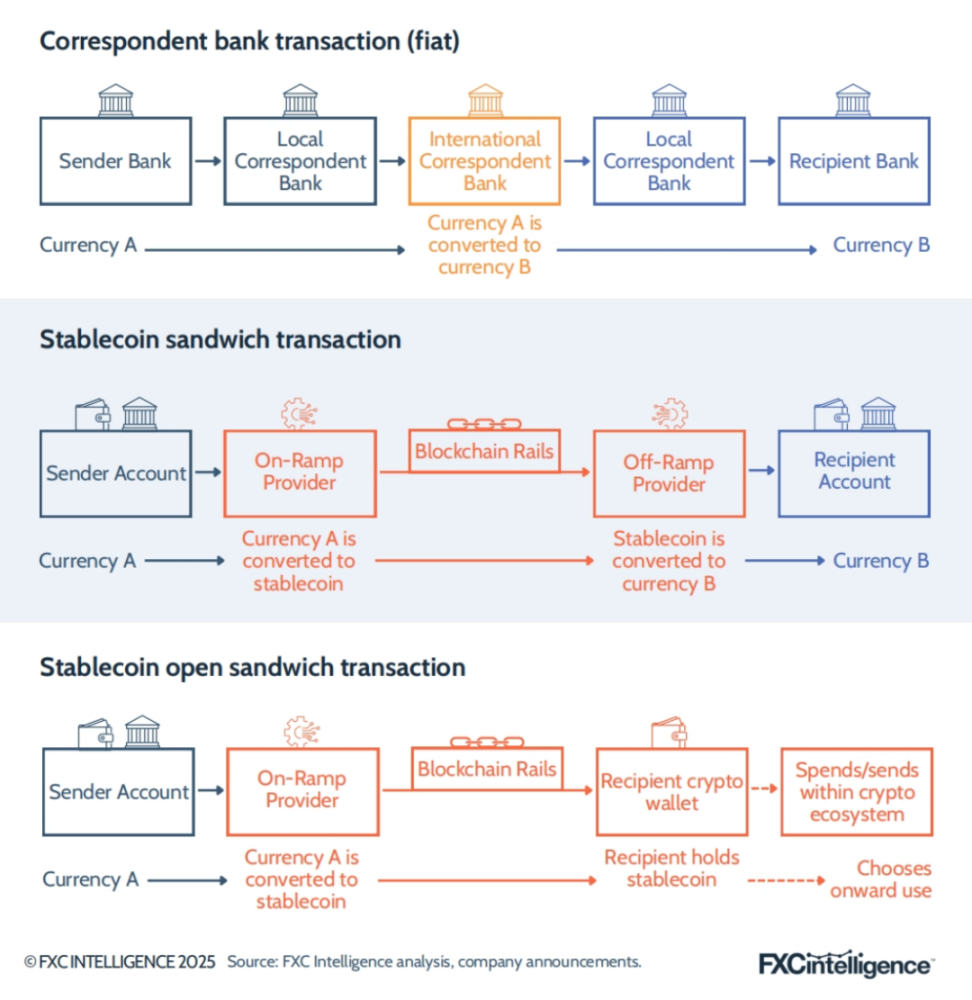
Orbital's Mason gave an example: "In traditional payment pathways, when making payments to emerging markets, a single transaction may involve six parties. Let's say my correspondent bank is Sberbank, whose underlying bank is JPMorgan. There are already three banks in this chain that must fulfill regulatory obligations, and there may be three more on the receiving end. Because the destination is Colombia, each institution requires visibility into the payment. Coupled with the varying operating hours of each bank, the money could remain stuck in the system for two weeks before the recipient receives it."
This delay is particularly fatal if the payment is for perishable goods or other time-sensitive goods and services, which ultimately creates unnecessary friction for local businesses, limits their growth space, and becomes an obstacle to their internationalization. The "stablecoin sandwich" eliminates this lengthy chain, but still requires institutions or individuals at both ends of the chain to be willing and able to quickly complete the exchange between fiat currency and stablecoins. This was a major challenge at first; as stablecoins have gained attention in many emerging markets, local demand for stablecoins has increased, providing better liquidity for such transactions.
Mason added: “Even though local banks in some markets are not technologically advanced, we are already seeing the ability to do an ‘executable rate stablecoin sandwich’ grow. For example, if someone gives me euros, I can immediately buy USDT in real time on the European liquidity side, sell USDT in real time in Mexico, and remit Mexican pesos through my Mexican banking partner. The whole process can be completed in 5-10 minutes or even less. In my opinion, this is the ‘golden egg’ in the field of cross-border payments. Although it still depends on the capabilities of emerging markets, everyone is catching up quickly.”
Whether fast, low-cost stablecoin payments can truly take off depends crucially on the efficiency of the "deposit and withdrawal currency acceptance" process, with the "last mile" being particularly crucial. This also means that institutions with deep roots in the fiat currency world are more likely to switch into the market.
We started out in traditional finance and have already established the fiat currency channels for both collection and payment—these channels remain essential to the entire process. Now we simply need to introduce new technologies in the middle to make payments faster and more streamlined.
—Dimitrova, OpenPayd
However, the last mile isn't always necessary. As stablecoins expand their use, more and more people are looking to receive them directly, rather than redeem them for fiat. Fireblocks' Shaulov revealed, "We're already seeing one side of the sandwich starting to disappear." This type of transaction, known as the "open stablecoin sandwich," is believed by some to eventually become mainstream.
Mike Hudack, co-founder and CEO of Sling Money (a consumer-facing stablecoin remittance company), bluntly stated: "People have to slowly accept the reality that one day, people will no longer be transferring money in and out, and the money on the chain will be the money itself. No one will care about the underlying infrastructure anymore, and your Visa debit card will actually be powered by the stablecoin or tokenized deposit in your wallet."
However, when this day will arrive remains uncertain. While the "open sandwich" model has already seen demand in certain scenarios, most believe that fiat currency channels at the front and back of the market will not disappear in the next few years.
Dimitrova concluded: “The need for interoperability between fiat currencies and stablecoins will continue for years to come.”
3. Opportunities in Data
Quantifying the current market size of stablecoin cross-border payments is not easy: although there is publicly available data on the total amount of stablecoin transactions, it is unclear how much of it is used for cross-border payments.
Data from Visa and Allium show that the total transaction volume of all stablecoins on all blockchains in 2024 will be approximately US$5.7 trillion, with 1.3 billion transactions. In the first half of 2025 alone, the total transaction volume will reach approximately US$4.6 trillion and 1 billion transactions, and the full-year figures are expected to be significantly higher than last year. However, the vast majority of these transactions are capital transfers in trading scenarios, because investors often use stablecoins as a "stable harbor" between buying and selling highly volatile cryptocurrencies.
The internal data of the leading companies can better reflect the size of the market segments. According to Harmse, BVNK (regarded as one of the largest players in the field) processes about $15 billion a year, of which about half comes from B2B payments, which is also the largest segment in cross-border payments. Gertman said that Conduit's annualized transaction volume is $10 billion, and the company estimates that this accounts for about 20% of the global B2B stablecoin cross-border payment market; Orbital's annualized scale is $12 billion.
3.1 The Total Addressable Market (TAM) of Stablecoins in Cross-border Payments
Data previously released by FXC Intelligence indicates that the total global cross-border payment volume (including wholesale transactions) will reach approximately $194.8 trillion in 2024, with non-wholesale transactions accounting for $40 trillion. Currently, the actual scale of stablecoins in cross-border payments remains in the "billions of dollars" range, accounting for less than 1% of the total market. However, their total addressable market (TAM) is significantly higher.
“The total stablecoin market cap is about $250 billion right now—that’s nothing,” Paxos’ Kendall noted. “Once it becomes widespread, I believe it will be a collaboration between regulated institutions like us and trillion-dollar investors.”
To define the accessible market for cross-border stablecoin payments, we must focus on the regions where companies report their capital flows: emerging markets. Orbital's Mason summarized: "The most profitable segments globally are precisely the three capital channels underlying capital flows. Traditional transaction banks profit handsomely from these channels, but opaque fees and slow processing times create significant pain points:
- flows from developed to emerging markets;
- flows from emerging to developed markets;
- Interflows between emerging markets.
This opportunity also manifests itself within Fireblocks' own business landscape. Shaulov stated that the company currently primarily serves regional corridors: two-way flows between Latin America and the US and Europe; two-way flows between Africa and Europe, as well as parts of the US; and flows between the Asia-Pacific region and the US and Europe.
Based on this, a reasonable framework is to lock the main opportunities for stablecoins into markets outside the G20, and secondarily outside the G10 (Belgium, Canada, France, Germany, Italy, Japan, the Netherlands, Sweden, Switzerland, the United Kingdom and the United States).
Therefore, we consider the non-G20 market as the base addressable market (TAM) and the non-G10 market as the upside case. Under this framework, the base TAM for stablecoin cross-border payments is currently $16.5 trillion, representing 41% of the total non-wholesale market; while the upside case TAM reaches $23.7 trillion, representing 59% of the non-wholesale market.
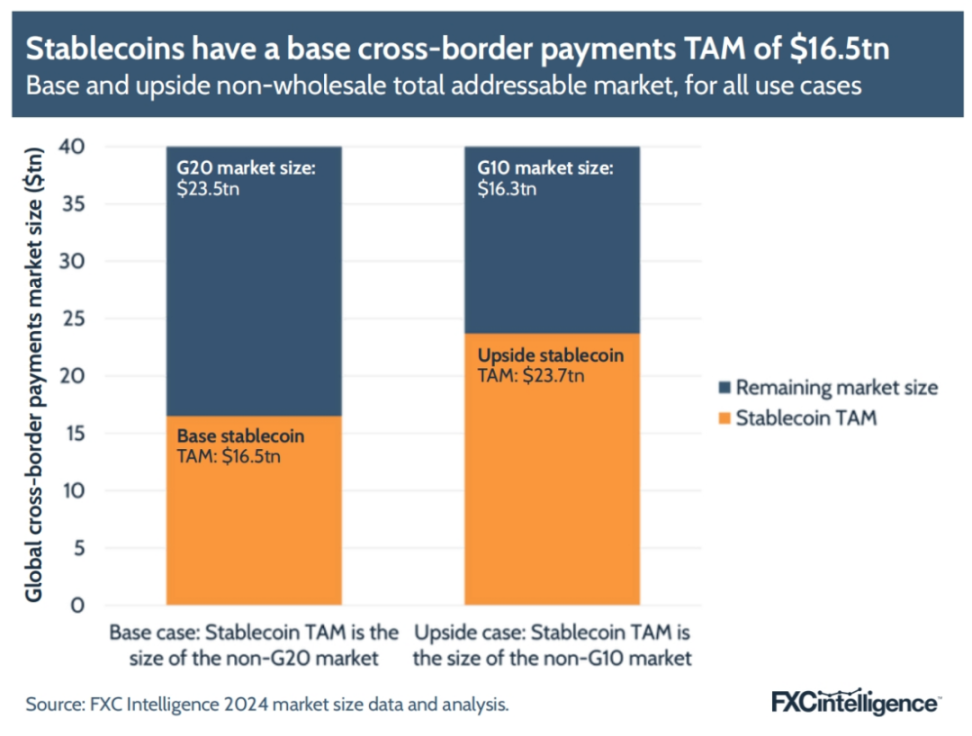
Looking at the different scenarios, B2B is undoubtedly still the biggest opportunity, and this also applies to cross-border fiat currency payments. However, the differences between the G10 and G20 result in a significant gap between the baseline scenario and the optimistic scenario.
Although China belongs to the G20, not the G10, it is a major exporter of funds, making it a key contributor to the optimistic scenario. Besides China, several other countries significantly increase the TAM for specific scenarios. For example, in C2C remittances, the gap between the baseline and optimistic scenarios is the largest because the G10 does not include the core C2C exporters of the G20—in addition to China, Saudi Arabia, Russia, the UAE, and India.
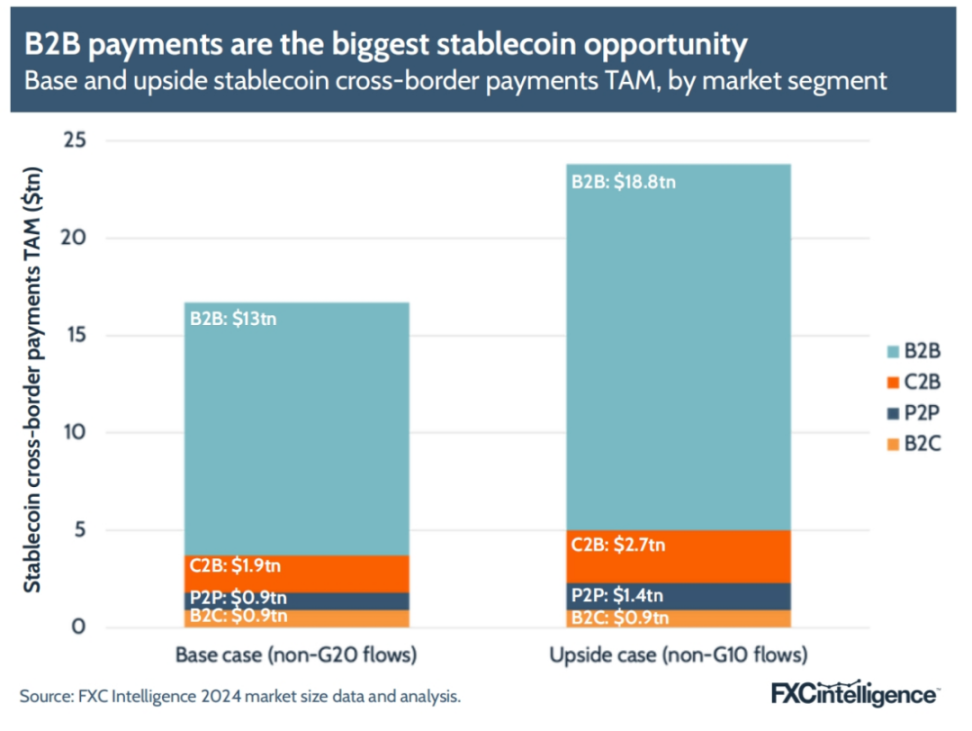
However, while emerging markets remain the primary addressable market, this may not always be the case. Some players, such as BVNK, have seen other markets begin to contribute small amounts of traffic.
BVNK's Harmse said: "We see that flows in the 'east-west' direction, for example, remittances from Hong Kong to the US can sometimes be difficult, even though the financial infrastructure in both places is quite good. A lot of our business actually comes from B2B payments between global companies, and these transactions don't always involve emerging markets."
3.2 Regions with the Highest Potential for C2C Stablecoins
The opportunities at the global level have been roughly outlined. If we break them down by region, we can see more clearly the specific application of stablecoins in cross-border payments.
As part of providing retail pricing data for the Financial Stability Board's (FSB) Annual Progress Report on Cross-Border Payments, which monitors progress on the G20 Cross-Border Payments Roadmap, FXC Intelligence measured the average cost and timeliness of different payment types across global regional corridors. By mapping price and speed, we can identify which corridors offer the greatest opportunities for stablecoin payments.
In the C2C sector, the following areas stand out due to their high average costs and slow average delivery times:
- Cross-border remittances within Latin America and the Caribbean;
- Sub-Saharan Africa → Middle East and North Africa (MENA);
- Latin America and the Caribbean → North America;
- Sub-Saharan Africa → Europe and Central Asia.
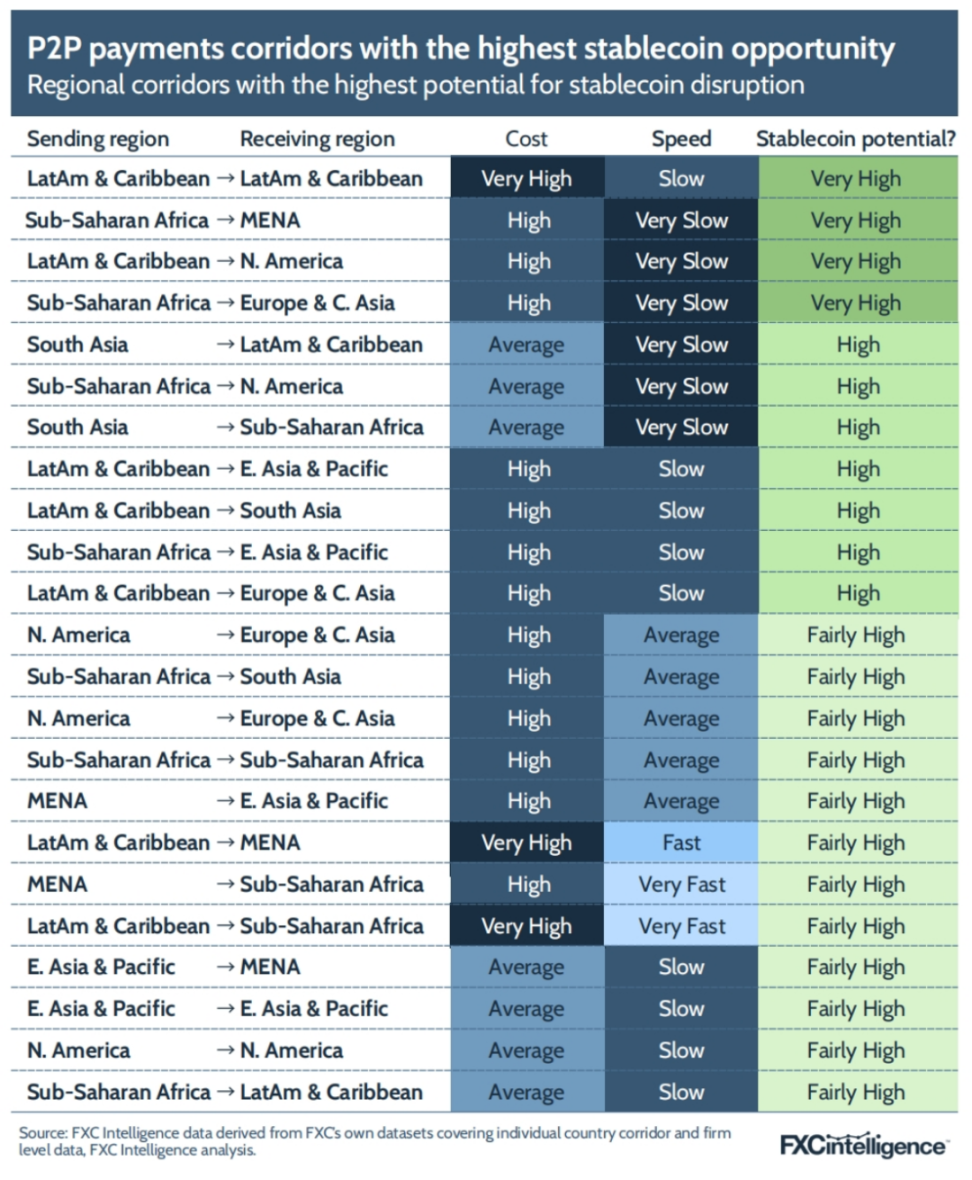
However, there are also some corridors where C2C payments currently have less potential for stablecoins because their costs are already low or very low and their speeds are average to fast. These corridors include cross-border remittances within Europe and Central Asia, remittances from Europe and Central Asia to South Asia, and remittances from North America to South Asia or Latin America and the Caribbean.

Judging from the global average remittance data, Sub-Saharan Africa has the highest overall potential - the average cost is extremely high and the average speed is extremely low; South Asia, as a recipient of C2C cross-border remittances, has lower potential.
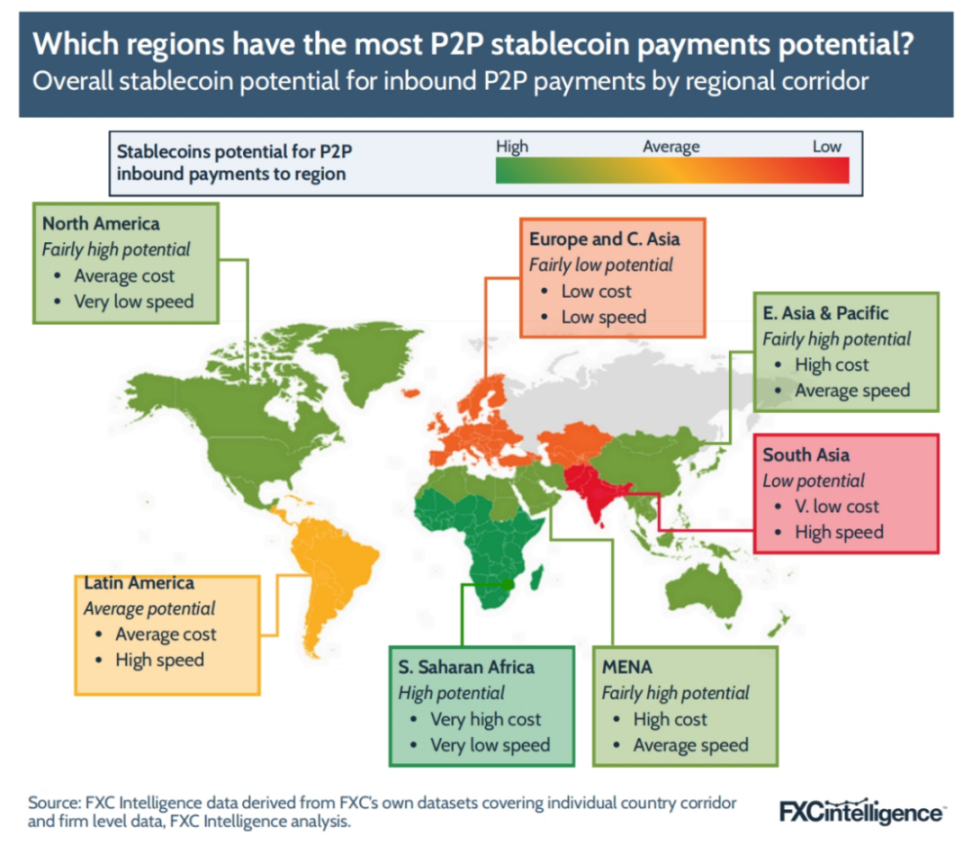
3.3 Regions with the Highest Potential for Stablecoins in B2B Payments
However, if we combine the data for B2B and B2C payments, the picture becomes slightly different—due to the specific corridors, costs and speeds can vary significantly. For cross-border payments, the regional corridors with the highest potential for stablecoins include:
- Sub-Saharan Africa → Latin America and the Caribbean
- Sub-Saharan Africa → East Asia and the Pacific
- Intra-Latin America and the Caribbean Corridor
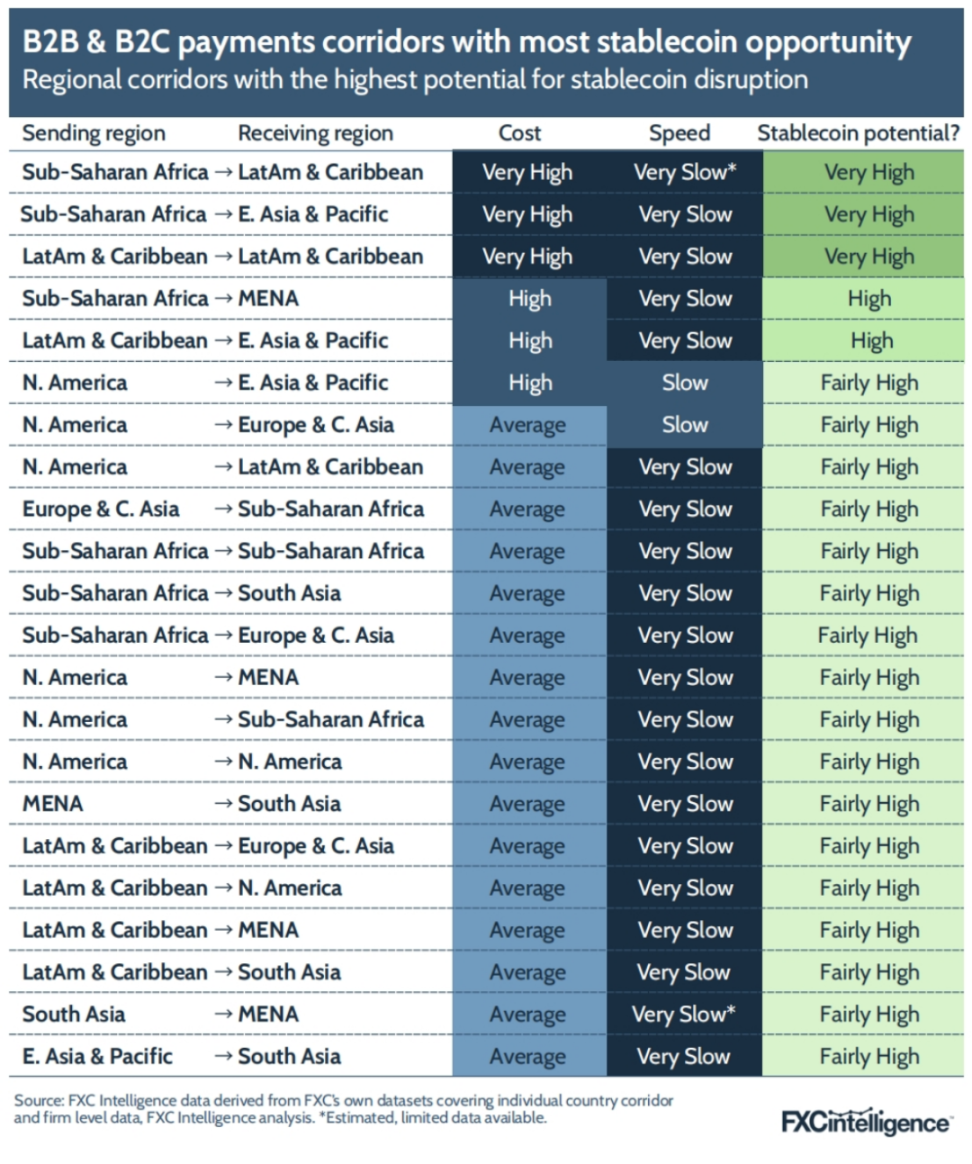
At the same time, a very small number of regional channels have very low potential:
- Payments within Europe and Central Asia have the lowest chance;
- payments between South Asia and North America;
- East Asia and Pacific → Latin America and the Caribbean payments;
- Payments from the Middle East and North Africa (MENA) to North America.
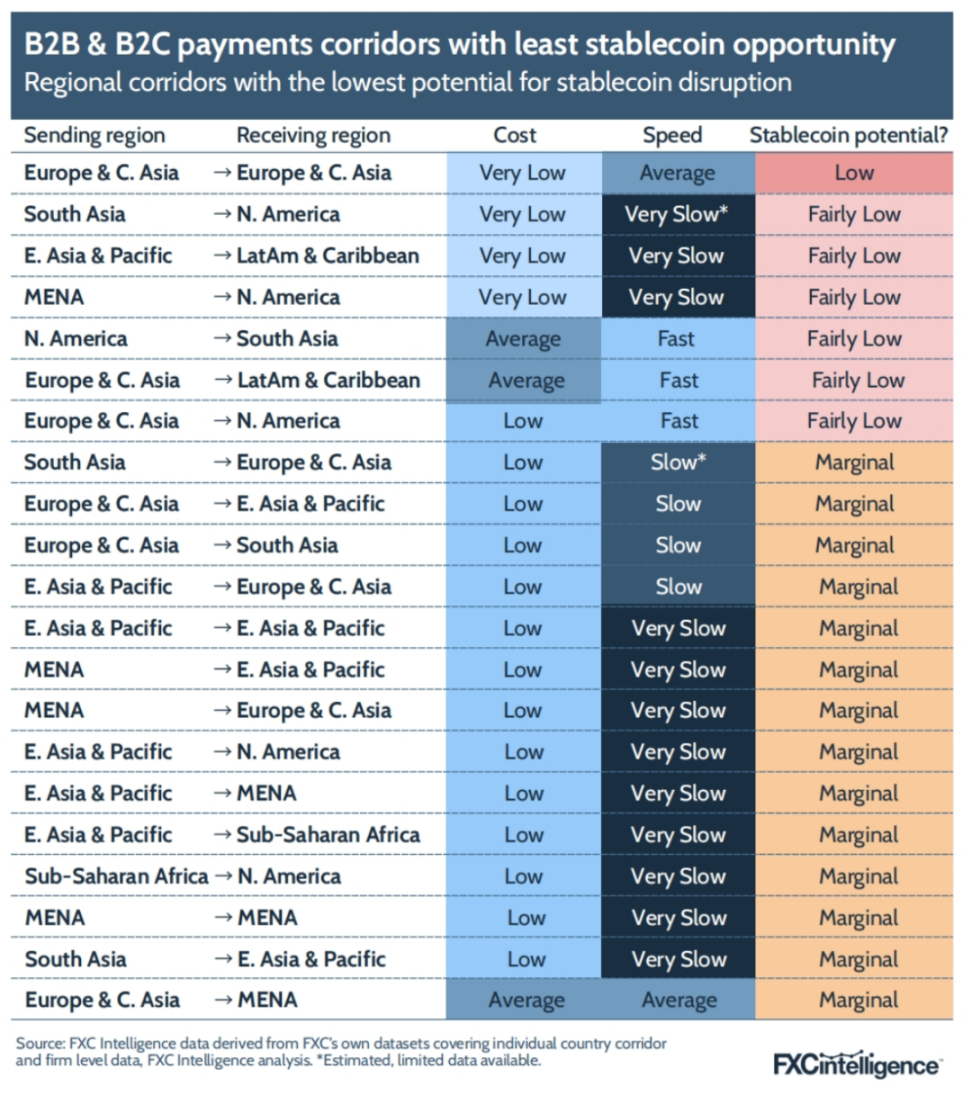
Globally, Europe and Central Asia currently have the lowest potential as a recipient market for cross-border stablecoin payments for both B2B and B2C, although individual countries may have exceptions. In contrast, East Asia and the Pacific region has the highest average recipient potential due to high costs and slow speeds.
4. Major Stablecoins in the Market
While there are a wide variety of stablecoins available for purchase, holding, and trading, not all are suitable for cross-border payments. This is partly due to design: the nature of the reserve assets and the level of transparency; partly to liquidity: whether the coin has sufficient counterparties in different currencies; and whether it can be reliably integrated into automated technical processes and readily redeemable for the required fiat currency.
The only two things that really matter about stablecoins are liquidity—enough people with different currencies participating; and an API that doesn't go down.
——Farman-Farmaian, Higlobe
Different needs have led to the emergence of different entities issuing stablecoins. In cross-border payment scenarios, the vast majority are pegged to the US dollar. The most well-known are Tether's USDT and Circle's USDC, both of which have the largest market capitalizations. There are also other currencies with smaller circulations but which have attracted significant attention due to the backgrounds of their issuers.
PayPal's PYUSD is still small, but has grown steadily thanks to its universal use across PayPal products, including Xoom remittances and PayPal checkout. Ripple launched RLUSD last year, primarily for its own blockchain network, which has long supported its cross-border payments business with the crypto asset XRP. The latest entrant is the Global Dollar (USDG), issued by Paxos Singapore in November, which is designed to comply with multi-regional stablecoin regulatory frameworks and become the core of its recently launched "Global Dollar Network" payment network. Stripe's Bridge has also launched USDB, which is dedicated to its cross-border payment solutions. Unlike other currencies, USDB is not for retail transactions and is only used as an internal settlement token for Bridge.
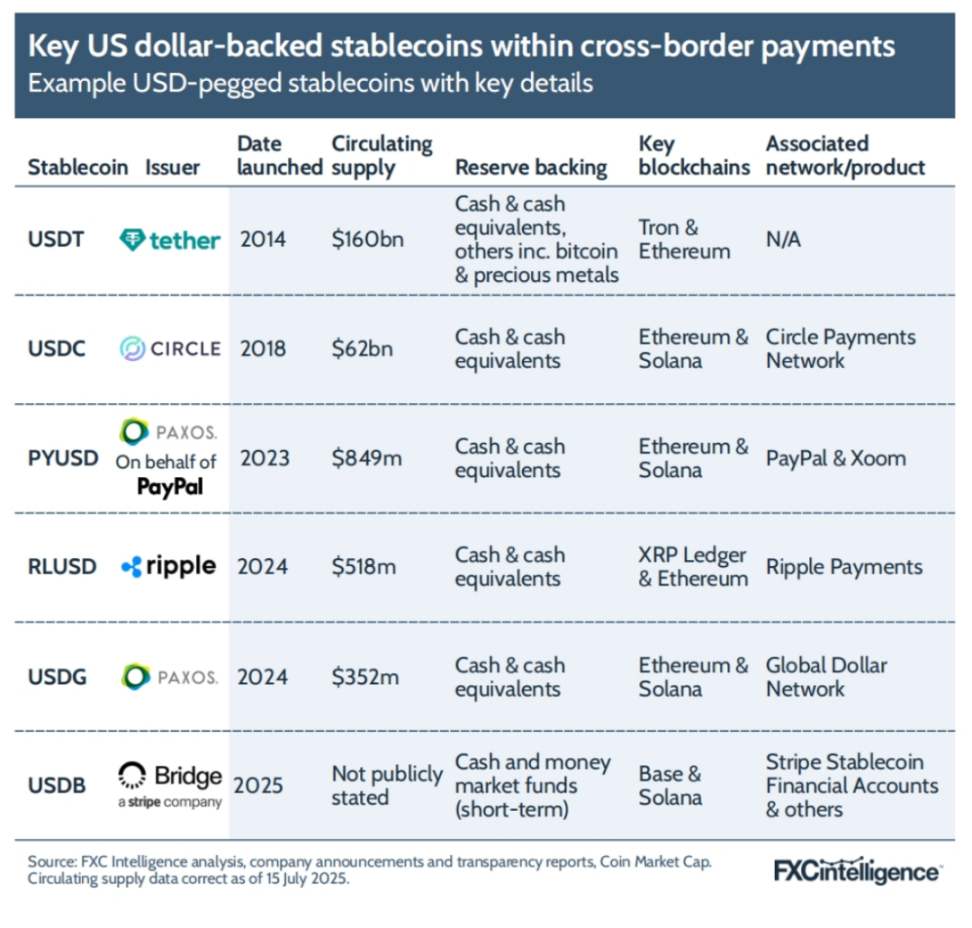
4.1 Which stablecoins dominate the market?
Even in the payments sector, where there are numerous stablecoins, USDT and USDC remain dominant, with a combined market capitalization exceeding 80%. USDT's significantly larger size makes it the preferred choice for some service providers, while USDC's scale is also sufficient to make it the preferred choice for many compliant institutions.
There are key differences in the composition of their reserves, which may cause some concerns: USDT includes non-traditional assets such as Bitcoin and precious metals in a small number of its reserves; USDC's reserves are only made up of cash and cash equivalents in US banks. In addition, USDT's reserves are held in offshore institutions and the frequency of transparency reports is low, which has led some US financial institutions to stay away from it. However, most institutions in the industry do not mind using USDT, and due to its huge circulation, it is still necessary in some scenarios.
Orbital’s Mason said: “I personally believe that Tether always has sufficient reserves to support USDT liquidity.”
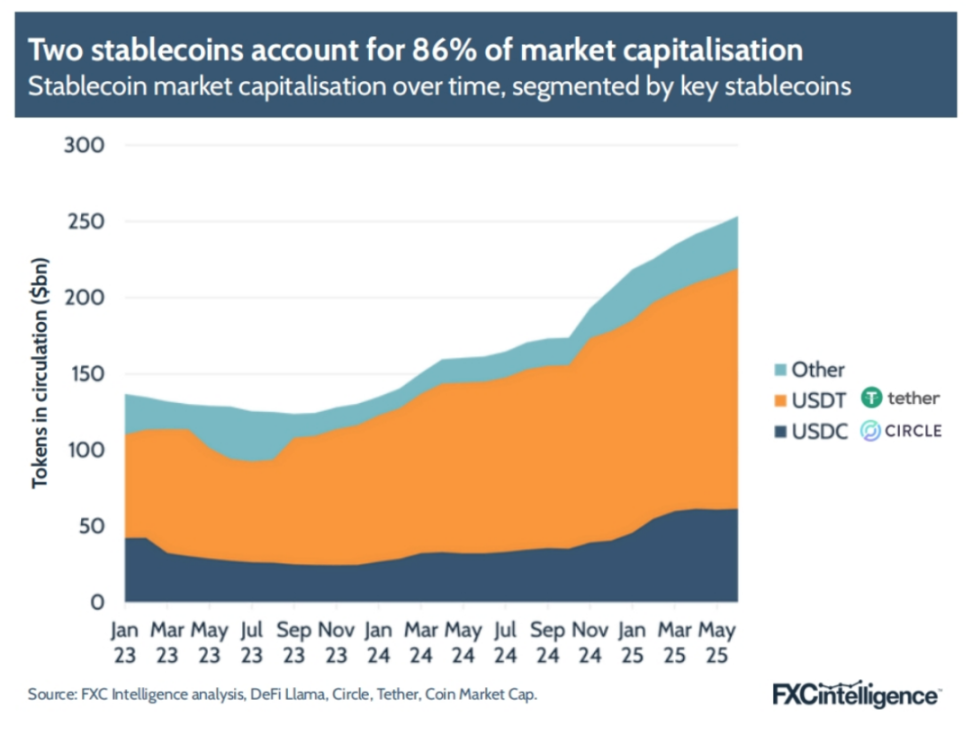
4.2 Differences between different blockchains
Although stablecoins are the core technology, the blockchain "track" on which they operate is equally critical; the differences in capabilities of different chains directly affect their adaptability in payment scenarios.
For Circle, its USDC is not limited to cross-border payments, but is aimed at multiple uses, so the company has been pushing for native issuance on as many chains as possible, currently covering 23 chains. Circle's Chandhok said: "We have built a strong infrastructure to issue stablecoins on these chains and manage liquidity between chains." However, despite the wide coverage, the circulation of USDC is still concentrated on a few chains: Ethereum accounts for 63%, followed by Solana, which accounts for only 12%.
USDT is also heavily invested in Ethereum, with approximately 40% of its circulating supply on the chain. While this percentage is lower than USDC, USDT's larger total issuance means that its actual amount on Ethereum is actually higher. However, the largest share of USDT is held on TRON, accounting for approximately 51%. Circle previously issued a stablecoin on TRON but decided to withdraw in early 2024, citing regulatory and compliance concerns.
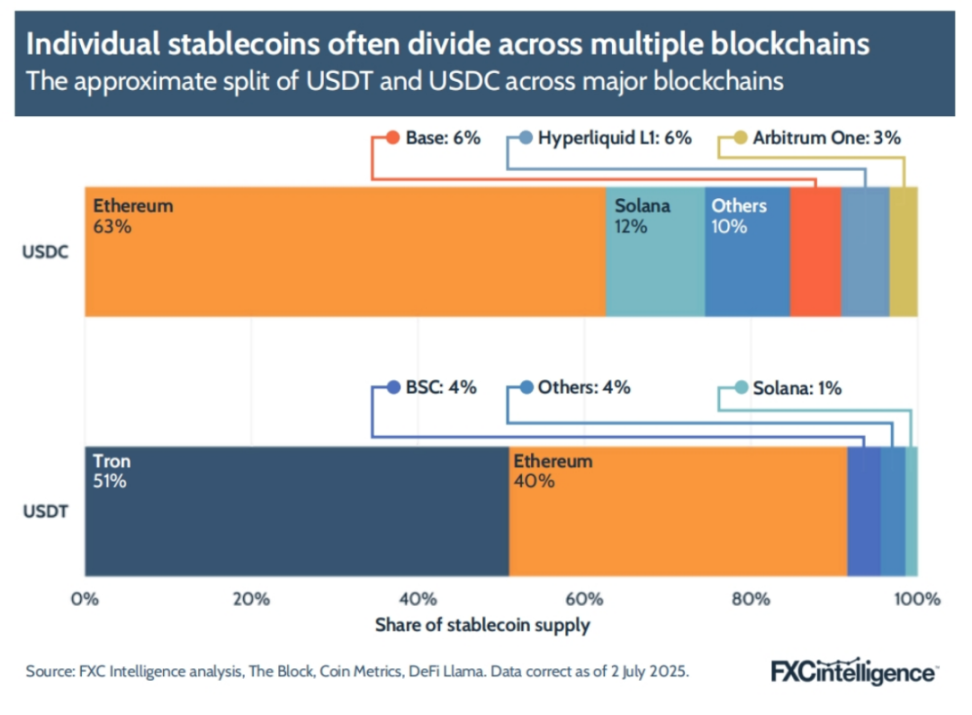
While companies using a specific stablecoin for cross-border payments are not automatically restricted to a single blockchain, they tend to choose a relatively limited number of blockchains. This is because each blockchain not only needs to be individually integrated into its internal systems, but also has different operating logic and technical standards; having to transfer stablecoins between multiple chains can introduce friction in the process.
Blockchains favored by major cross-border payment stablecoins can be broadly categorized into two types: Layer-1 and Layer-2. Layer-1 is the underlying blockchain, while Layer-2 is built on top of it, typically to increase speed and reduce costs.
In terms of total value locked (TVL)—the total value of all digital currencies (including stablecoins and other crypto assets) on a given chain—Ethereum leads by a wide margin, followed by Solana. However, there are significant differences between the two chains in terms of the number of transactions they can process and the cost of each transaction.
Ethereum's transaction speed is relatively slow: the reported maximum is approximately 62 transactions per second (TPS), with a theoretical ceiling of approximately 119 TPS (this figure is only a rough estimate and is almost impossible to achieve in reality due to network friction). In contrast, Solana has achieved a maximum TPS of approximately 2,900, with a theoretical ceiling believed to be around 65,000. For reference, Visa's average TPS in fiscal year 2024 was approximately 9,600.
The difference in transaction costs between the two chains is even more pronounced. Average transaction fees fluctuate significantly over time and day, directly impacting businesses' baseline costs. Data from Token Terminal shows that over the past year, average Ethereum transaction fees (also known as "gas fees") have ranged from just under $0.40 to over $8. Solana's highest value, on the other hand, has been just over $0.03, with the lowest being less than a cent.
Although Ethereum is relatively expensive and has a low transaction limit, its token standard is widely supported, which means that even if Layer-1 is not used directly, there is still a market demand for funds to flow on a derivative version of Ethereum. As a result, multiple Layer-2 chains have emerged, such as Base and Arbitrum-One. They not only have higher maximum TPS and lower average transaction fees, but also provide a variety of payment-friendly features, which are very attractive to some service providers.
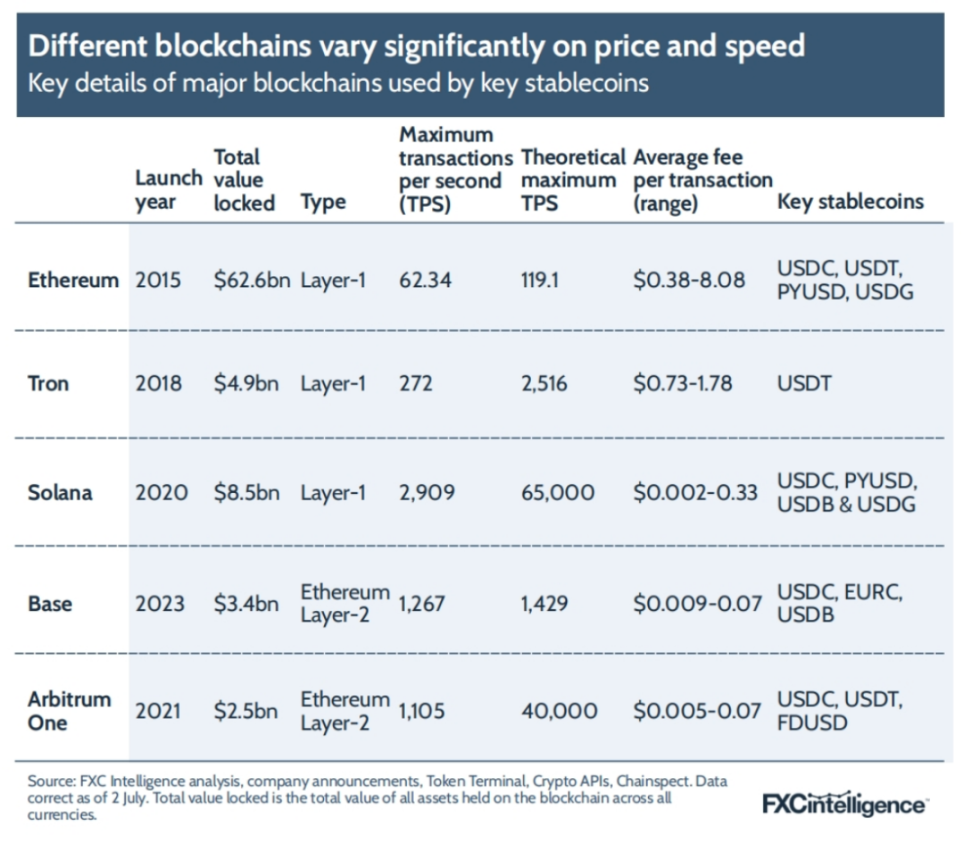
4.3 How the use of key stablecoins is evolving
Although USDT has a larger circulation than USDC, transaction data from the Ethereum blockchain shows that there are differences in their usage.
Although USDT has over 60% more circulating supply on Ethereum than USDC, the number of transactions between the two is much closer; since the end of 2024, USDC's transaction volume has only slightly fallen behind USDT.
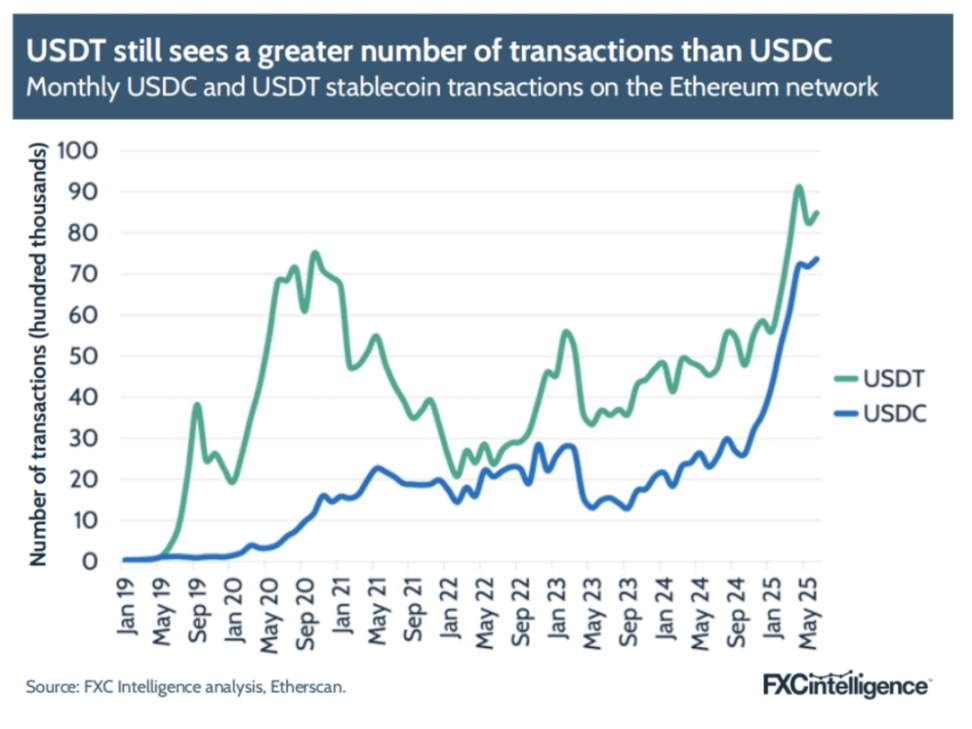
At the same time, since November 2024, the total transaction volume of USDC on the blockchain (that is, the value actually transferred through the stablecoin) has surpassed USDT, and the gap has widened significantly in the first half of this year.
It’s unclear what’s driving this trend, and multiple factors are likely involved. However, growing interest in stablecoins within the payments industry, with many players clearly favoring USDC, may be at least partially contributing.
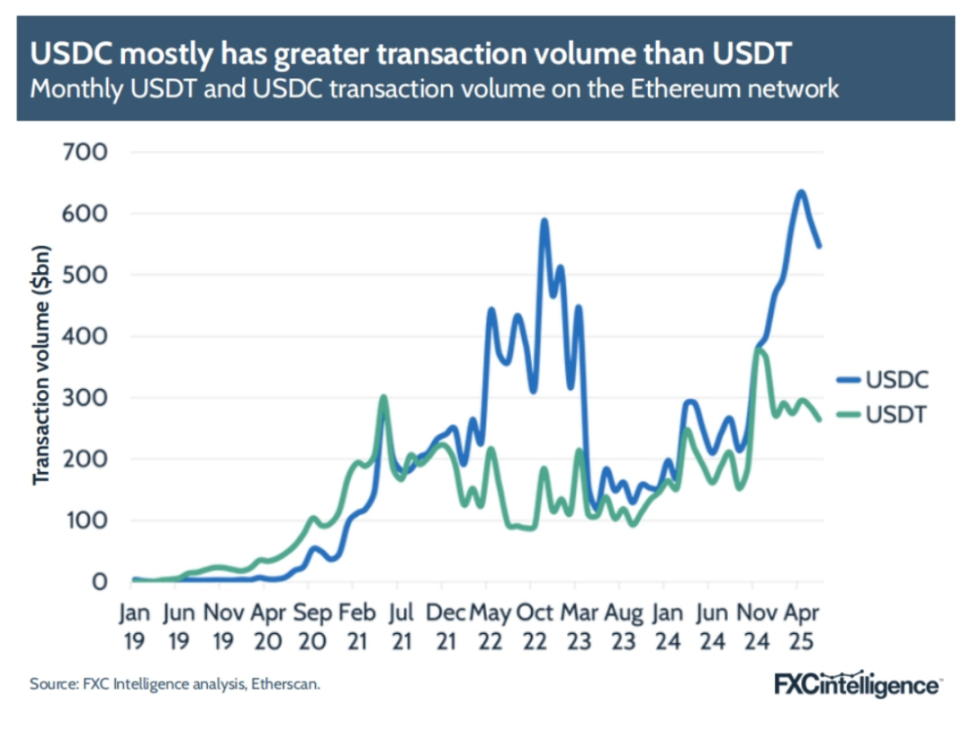
Notably, since 2020, the average transaction value of USDC has consistently been higher than that of USDT, suggesting that, at least on the Ethereum blockchain, people prefer to use USDC for large transfers. This doesn't mean that USDT isn't used for high-value transactions—the average transaction value for both is over tens of thousands of dollars—but it does reflect the differences in the typical use cases of the two stablecoins.
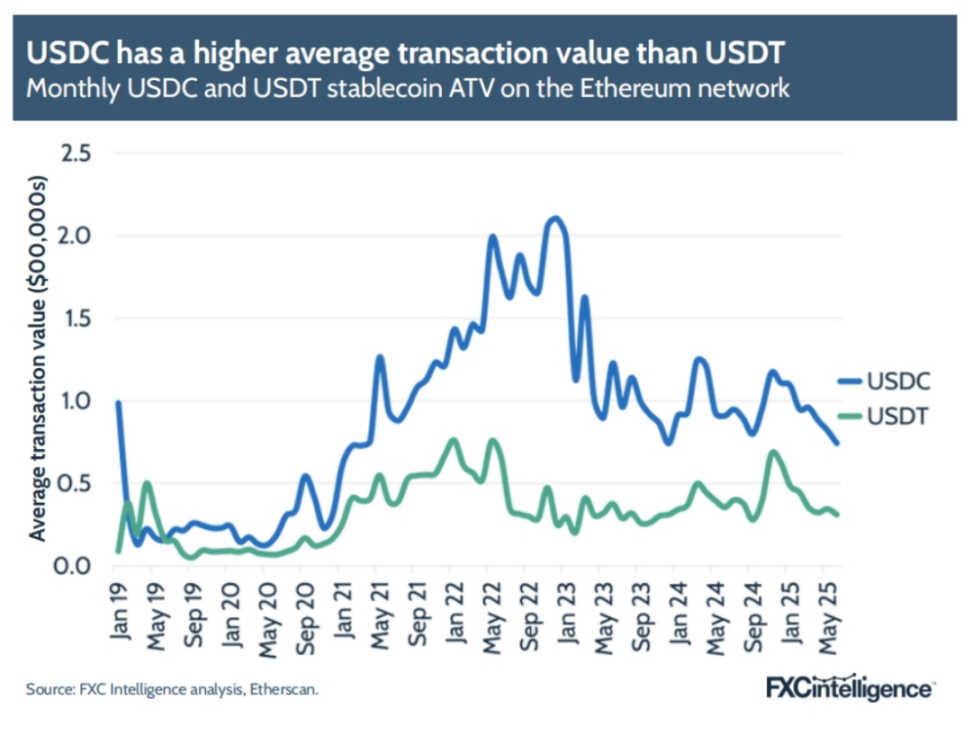
5. Major Participants in Cross-Border Stablecoin Payments
It is a rather complicated task to outline the core players in the stablecoin cross-border payment track: there are a large number of companies in this field, and new small companies emerge almost every once in a while; at the same time, more and more "traditional finance" (TradFi) institutions are also incorporating this technology into their own businesses. We try to use the following figure to present the overall picture of the current market. This picture does not exhaust all companies involved in stablecoins, but focuses on key players active in this field, large or small.
Although companies such as BVNK, Fireblocks, and Bridge are involved in multiple aspects of stablecoin cross-border payments, the industry can still be divided into several key sectors:
1. Stablecoin issuance and white-label issuance services: There are companies that issue stablecoins themselves, as well as companies that provide white-label issuance solutions to others.
2. White-label payment infrastructure (B2B2X): A growing number of service providers are offering white-label payment capabilities to other industry players. These models range from turnkey, complete networks to simply enhancing the existing network graphs of major payment institutions. These solutions are not directly targeted at end users, but rather empower other payment service providers.
3. B2B payments for businesses: A large number of companies provide B2B payment services directly to businesses in stablecoins, with significant differences in the size of their customer base.
4. Payroll and Contractor Payments: This includes payroll and contractor payment providers, as well as companies that provide support to freelancers who receive such payments.
5. Consumer Remittances: Inevitably, there are also service providers that focus on individual consumer remittance scenarios.
6. Stablecoin acquiring: There are organizations that help merchants accept stablecoin payments, and a small number of companies provide solutions for issuing stablecoin prepaid cards and digital wallets.
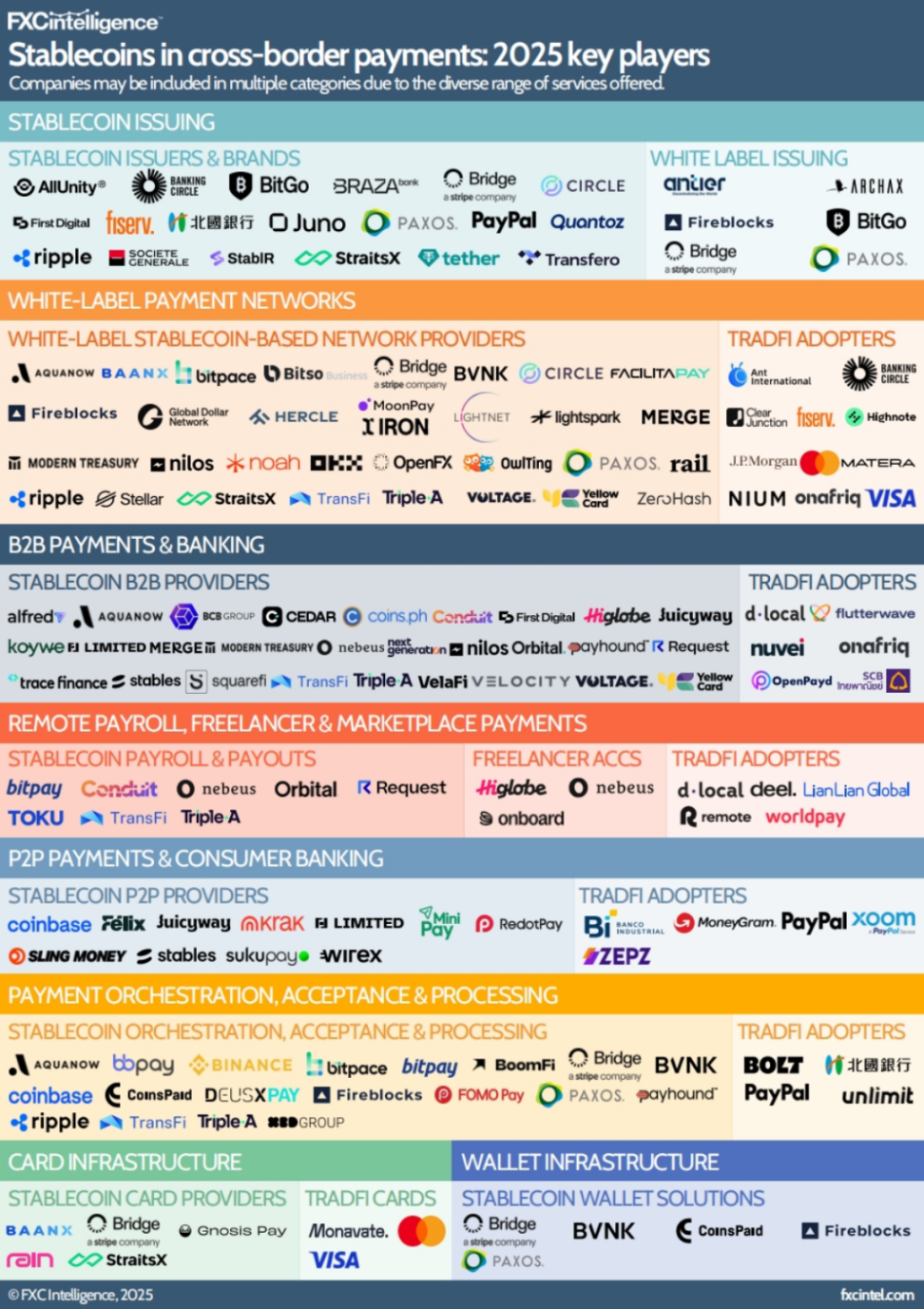
VI. Key Opportunities and Application Scenarios
While emerging markets are the core focus of stablecoin cross-border payment opportunities, the wide range of participants reflects the emergence of increasingly diverse application scenarios, some of which are derived from and reinforce each other.
6.1 Instant Settlement
Among the many advantages brought by stablecoins, "instant settlement" was repeatedly mentioned by many respondents interviewed for this report. The main reason is that it is in sharp contrast to the settlement methods commonly used in current cross-border payments.
“The reason that incumbents can do ‘instant payments’ today is because they have pre-stocked liquidity on both ends,” explains Conduit’s Gertman. “If you send money from Brazil to Europe today, it may seem to you as a customer that the money is instantly in your account. But underneath, there is actually a pool of euros sitting in an account in Europe waiting to be distributed to customers, or there is an overdraft facility provided by a European bank.”
This practice, commonly used by traditional cross-border payment institutions, usually relies on pre-funded "nostro" and "vostro" accounts - that is, foreign currency accounts opened by domestic banks at overseas correspondent banks, which are called "nostro" for domestic banks and "vostro" for overseas correspondent banks.
People often compare stablecoins to "digital nostro accounts." When you use stablecoins, you no longer need to spend energy on pre-financing.
—Nikhil Chandhok, Chief Product and Technology Officer
This settlement method is called "netting": the settlement of multiple transactions is consolidated, and the company only needs to pay the difference between payables and receivables. This method can significantly reduce the amount of working capital a company must reserve. Stablecoins go a step further, enabling instant settlement of every transaction.
You don’t need to estimate the other party’s liquidity or predict demand, you just need to initiate a transaction because Party A in Country A and Party B in Country B share the same ledger.
——Chandhok, Circle
For industry participants, this means significantly reducing the working capital required to operate. Higlobe's Farman-Farmaian gives an example: "With instant settlement, instead of having to tie up $1 million, I only have to keep $10,000 because Mastercard knows they can withdraw the funds from my account instantly—our working capital is now zero."
Farman-Farmaian believes that as more and more institutions adopt this model, the chain effect will be more far-reaching. "The trillions of dollars currently locked in pre-funded accounts around the world will be released in the next five years," he said. "I don't know where this money will eventually flow, but if the market efficiency increases exponentially, real financial innovation will happen." BVNK's Harmse bluntly said: "Pre-funding is a big problem that has not been effectively solved in the payment field for 25 years." He defined this as "a technical problem."
However, instant settlement also has potential drawbacks: the lack of delay means transactions cannot be reversed mid-sentence. Fireblocks' Shaulov noted, "When SWIFT was hacked, 80% of the funds were recovered because settlement took three days, giving Deutsche Bank analysts time to roll back. However, if a stablecoin wallet is compromised or transferred to the wrong address, recovery becomes difficult due to the instantaneous and irreversible nature of settlement."
Meanwhile, the fact that stablecoins don't require reserve reserves has attracted some companies, including MoneyGram, to incorporate them into their treasury management. However, not everyone is convinced: Wise is still observing the technology and has not yet implemented it in its treasury operations.
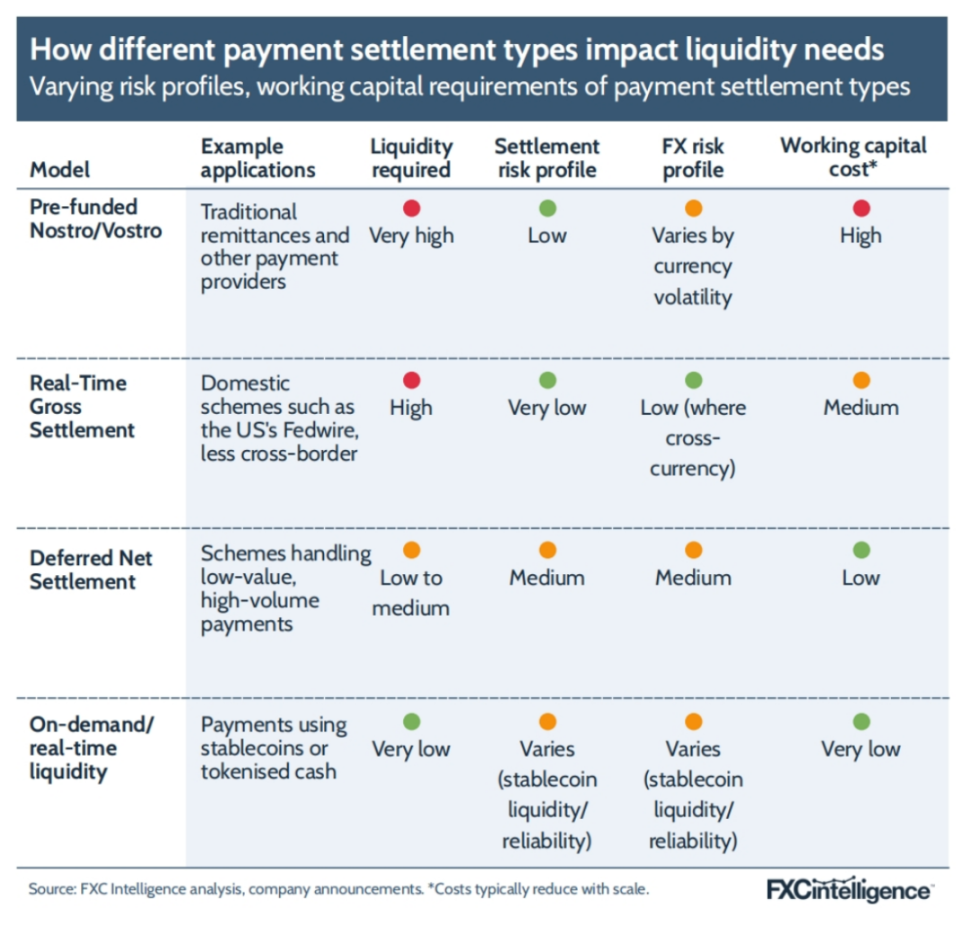
$6.20 Acquisition
While instant settlement isn't limited to any particular market, one of the most compelling use cases for stablecoins—and a key driver of their mass adoption—is that stablecoins like USDC or USDT are essentially digital representations of the U.S. dollar. Because they aren't actual cash, they're more readily available to many people around the world who want to hedge against the volatility of their local currencies.
Orbital's Mason uses Argentina as an example to explain: "If you are in Argentina and you don't want to hold pesos, and you may not be able to hold dollars directly due to local regulations, but you still want dollar exposure, then you will hold a stablecoin."
Turkey is also frequently mentioned. A 2024 Chainalysis study showed that Turkey has the highest per capita stablecoin holding rate in the world, with local purchases equivalent to 4% of GDP. "Turkey has high inflation, and people want to convert their wages into dollars immediately after receiving them. It is expensive and troublesome to convert money through banks, so they use Tether. But they don't know it is Tether, they just keep it in their crypto wallets as cheaper dollars instead of bank accounts," said Kendall of Paxos.
We may have underestimated the extent to which stablecoins provide global users with exposure to the US dollar. The demand for US dollars through stablecoins is like a tap that we have just turned on.
—Luke Tuttle, Chief Product and Technology Officer, MoneyGram
He described stablecoins as “democratizing the almost unlimited demand for dollars,” a sentiment echoed by Circle’s Chandhok, who called access to dollar banking services “a superpower.”
“People in the West don’t understand this,” he added. “For many businesses, especially those operating across borders, it’s very difficult to get a dollar bank account and get competitive foreign exchange rates. Crypto infrastructure, such as dollar stablecoin exchanges and on- and off-ramps around the world, solves these problems for them without having to rely on traditional banks.”
However, another driving force behind the further acceleration of demand is the market of "remote service professionals" that has emerged during the epidemic.
“There’s a new generation of highly paid individuals living abroad,” says Higlobe’s Farman-Farmaian. “These aren’t wealthy European and American individuals traveling the world for work, but rather the most educated individuals in the region, working remotely for European and American companies, earning somewhere between local and US wages, but significantly more than what they earn locally.”
His company provides dollar-denominated accounts for contractors and businesses in emerging markets. Crucially, the funds remain in stablecoins until users need them, at which point they can instantly convert them to local payment networks like Brazil's PIX. "It's like having an ATM in the sky; you can withdraw money anytime, and it's instantly in your account," he explained. This readily available liquidity, rather than monthly batches of conversions to local currencies, completely changes users' "relationship with money."
It's not just individuals who want to hold funds in stablecoins. For emerging market businesses that frequently conduct cross-border transactions, holding all or part of their incoming funds in stablecoins is also attractive. Orbital's Mason explained, "Some companies just want to operate in a USDT or USDC world. They don't want Mexican pesos, but rather hold stablecoins because they need to pay others later, or they might just convert a portion of it to payroll."
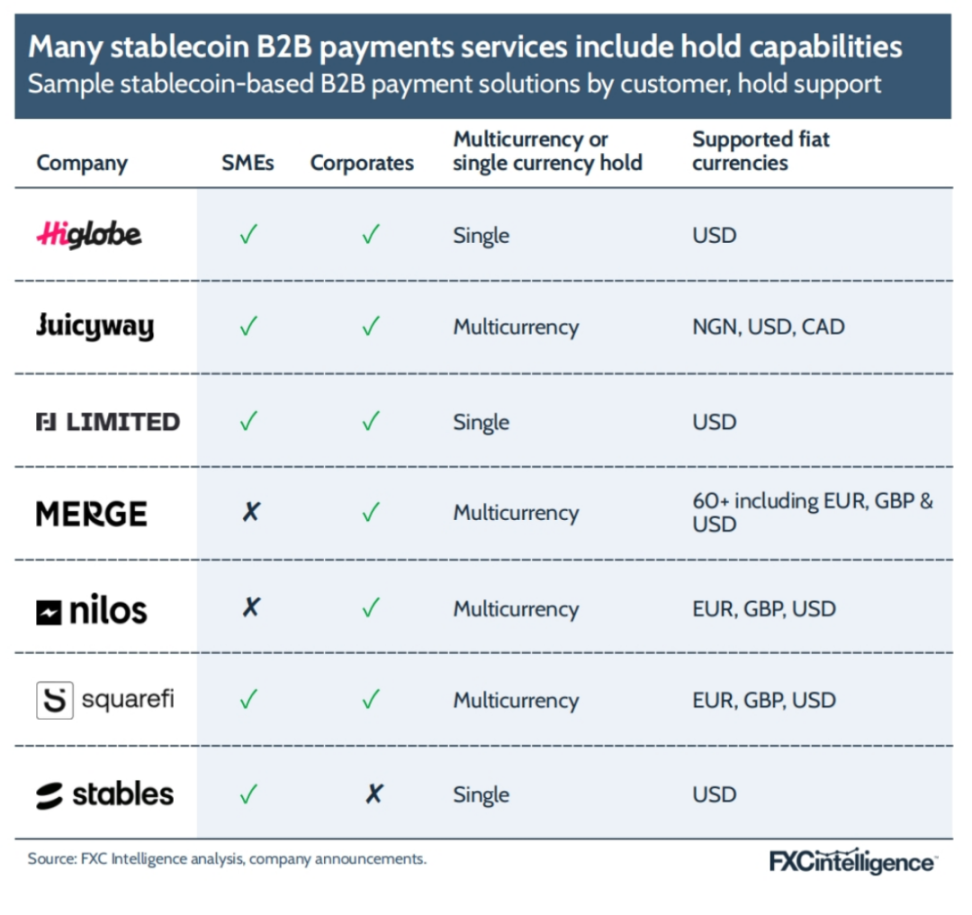
6.3 B2C Payments and Stablecoin Payments (pay-outs)
The flip side of the surging demand for holding stablecoins denominated in US dollars is the ability to make cross-border payments in stablecoins. Fireblocks' Shaulov points out that this has become a fairly common use case: if you have IT contractors in Colombia working for European or US companies, they often prefer to receive stablecoins rather than local bank wires.
A growing number of marketplaces and payment processors have integrated stablecoin payments into their product stacks. Worldpay, one of the world's largest payment processors, recently launched this feature. BVNK's Harmse said, "It's really merchant demand that's driving PSPs to think, 'Hey, what else can we add to our payment stack?'" He added that the growing popularity of stablecoins in emerging markets is a key driver of this surge in interest.
“You have a new payments technology now, and users in emerging markets are demanding it—whether it’s gig economy platforms looking to get paid or marketplaces needing to pay users or sellers.” While the payment use cases are diverse, Triple-A’s Barbier sees particular potential in using stablecoins to pay content creators. “The beauty of stablecoins is that even tiny amounts can be transferred economically,” he says. “For example, if a gamer or content creator earns just one dollar, they can actually receive it—because the cost of transferring it in a stablecoin is almost zero.”
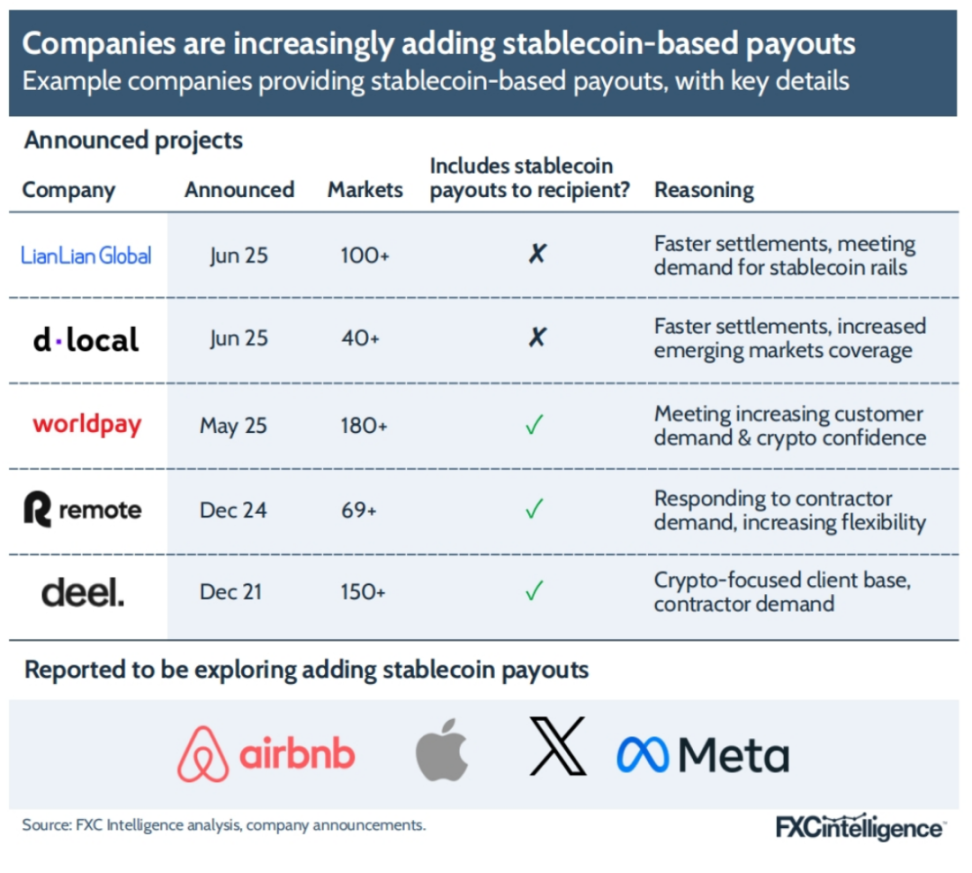
6.4 B2B Payments and Trade Financing
While B2C payments have garnered significant attention and offer significant potential for numerous participants, they still lag far behind B2B payments in terms of funding volume. BVNK's Harmse noted, "B2C may receive a disproportionate amount of exposure, but the real significant traffic comes from the B2B side."
Adoption here also exhibits a chain reaction: one use case in a market spawns more use cases.
Conduit's Gertman cites the example of some import-focused emerging market companies holding funds in stablecoins to circumvent foreign exchange controls related to the US dollar, and subsequently hoping to use these stablecoin balances for more transactions. "We offer this service to them, and they're very excited. Payments to China typically take three, four, or five business days for many countries around the world; I've seen delays as long as seven days. With stablecoins, payments arrive in minutes—not necessarily instantaneous, but incredibly fast."
We are starting to see some companies that have nothing to do with Web3 and have nothing to do with the technology industry starting to use USDT or USDC for payments.
—Eric Barbier, Founder and CEO, Tripple A
Fireblocks' Shaulov also believes that the increasing number of locally held stablecoins is a key factor driving the adoption of the technology in cross-border B2B payments. "There's now a sufficient supply of stablecoins in Colombia. When local importers purchase goods from Hong Kong, the funds are allocated in this way: exporters in Hong Kong or mainland China prefer to accept USDT," he said. "Due to the large inflow, it's actually cheaper to buy USDT in Colombian pesos, so it's naturally entering the trade finance market."
This phenomenon ultimately allowed the technology to penetrate sectors unrelated to early adopters, creating new opportunities for service providers. Triple-A's Barbier gave an example: "Some large fast-moving consumer goods companies received feedback from African distributors: 'We have trouble getting dollars to pay you, but we can easily get stablecoins—can we use stablecoins instead?' Naturally, these giants were reluctant to handle crypto assets directly, which is where Triple-A comes in."
6.5 All-day Settlement
While speed isn't an issue in many regions during weekday banking hours, weekends present challenges even in developed markets, particularly in settlement. "For some businesses, 24/7 settlement on weekends and holidays can be very impactful," said Triple-A's Barbier. "For example, in the remittance industry, they need to pre-fund payments with their payout partners. Being able to transfer funds in real time on weekends and bank holidays would significantly improve their working capital position."
This is one of the key reasons why MoneyGram decided to use stablecoins to manage its treasury. In certain markets and scenarios, stablecoins allow for faster movement between currencies. We often need to move funds to specific markets and predict the amount of currency we'll need over a given period. On weekends, when banking channels are closed, stablecoins allow us to operate around the clock and perform settlements and currency conversions more frequently.
—Tuttle, MoneyGram
This advantage also benefits other parts of the payment industry, including card issuers. Highnote, a card issuer, recently adopted a stablecoin solution to address settlement challenges during off-hours. "In the global payment system, both card organizations and projects like Highnote are required to hold a four-day deposit for the weekend, which is a significant challenge," he said.
BVNK's Harmse said, "The ultimate goal is to move the entire card network settlement process onto the blockchain—from the issuer and processor to Visa, the acquiring bank, and the merchant—using technology to solve the pre-funding problem, rather than forcing all parties to lock funds in accounts for long periods of time for risk mitigation."
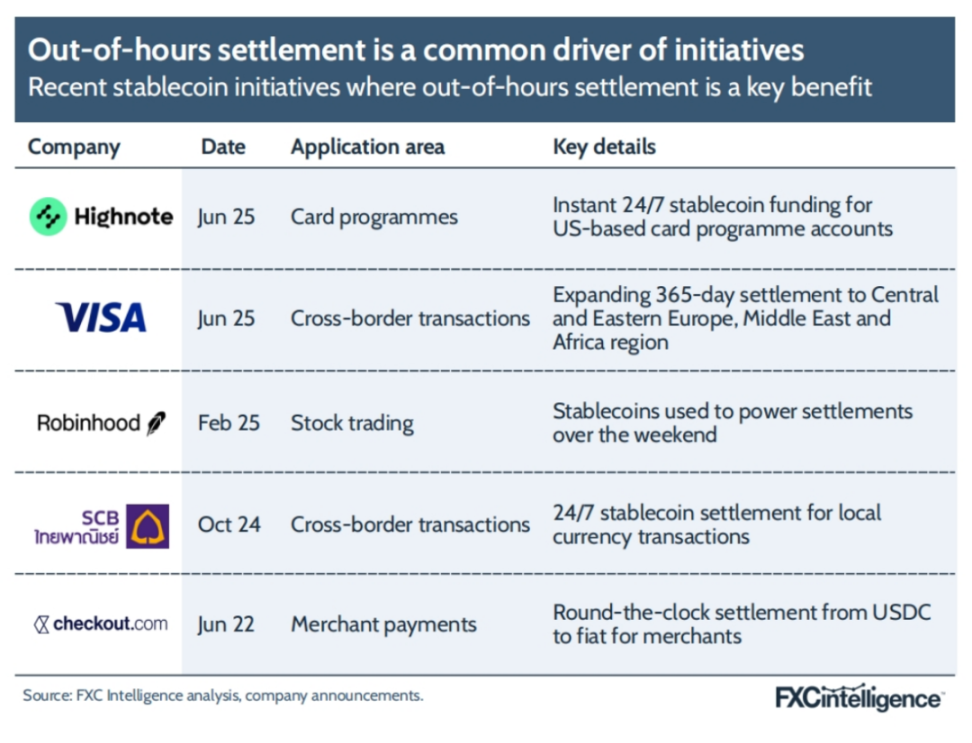
6.6 Alternatives to Credit Cards
Meanwhile, a potential use case emerging in certain markets is the use of stablecoins as a replacement for credit card payments, particularly in regions with high payment costs, such as the United States, where interchange fees are particularly problematic. This is believed to be a key factor in some US companies considering launching their own stablecoins following the passage of the GENIUS Act. Amazon, in particular, is reportedly exploring issuing its own stablecoin that users could hold and use for online purchases, thereby avoiding the interchange fees associated with these transactions.
In this scenario, stablecoins would effectively replace bank credit cards. However, not everyone agrees with this prospect.
Jack Zhang of Airwallex said: “I still struggle to understand why consumers would be willing to hold stablecoins. I get a lot of rewards with AmEx, and Apple Pay is just a swipe away. Will Apple support stablecoins? Will all acquirers accept stablecoins overnight? I think this is a trend that may happen in 5 to 10 years, or it may not happen at all.”
Higlobe's Farman-Farmaian disagrees, saying his company has seen signs of this happening. He points out that QR code payments are cheaper than card payments, prompting merchants to offer incentives like free drinks or food. "We believe stablecoins will erode bank card usage," he says. "This is already happening in some offline, fringe retail scenarios where there are no refunds or exchanges."
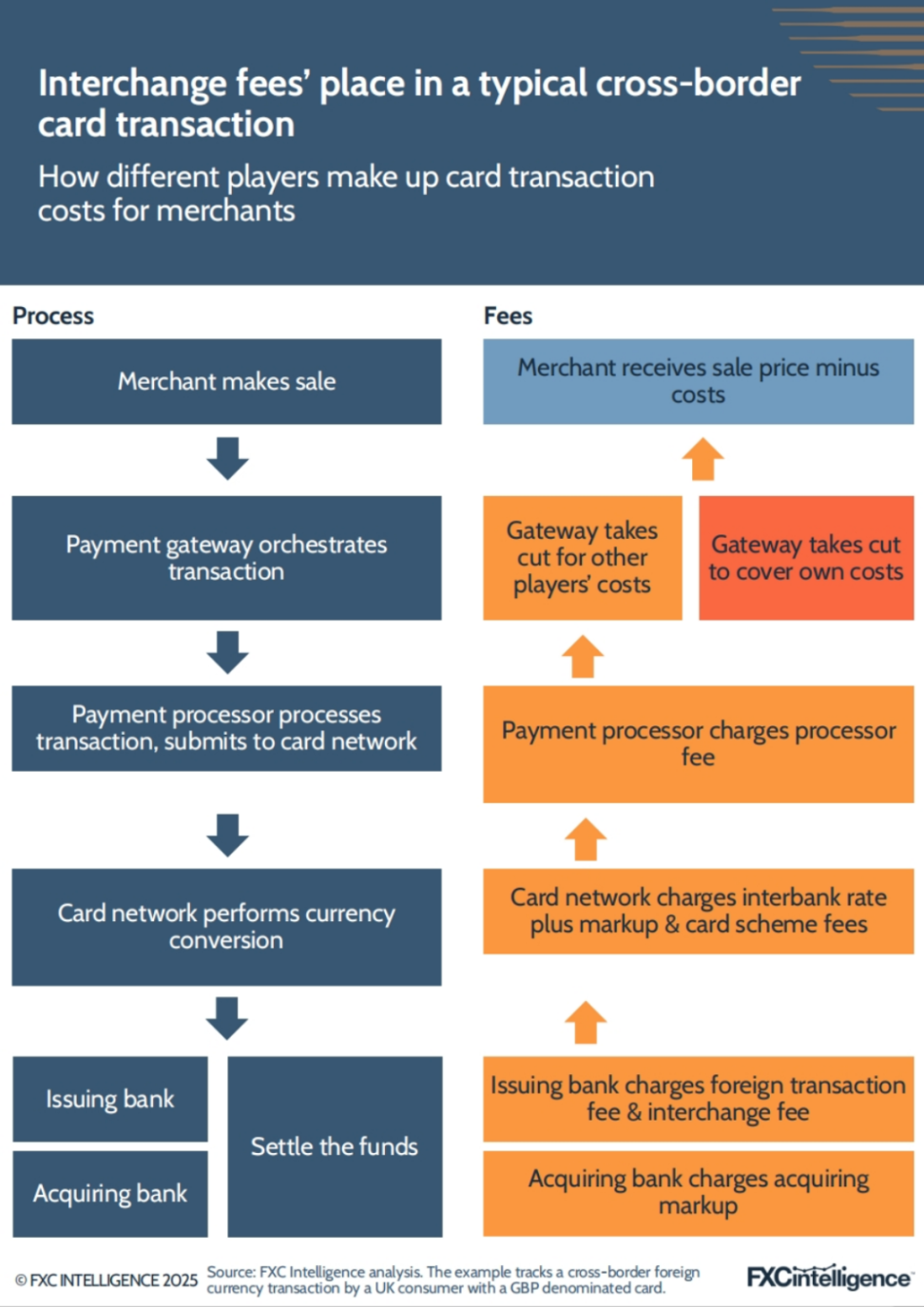
6.7 C2B Merchant Acquiring
If stablecoins are to gain market share from bank cards, businesses must be able to accept them as payment. Some companies are building businesses around this, simplifying the process and making it easy for merchants who don’t want to directly handle stablecoins or other crypto assets to do so.
Triple-A's Barbier, for example, said the company's original concept was to "enable merchants to sell to the 500 million users who hold stablecoins or digital currencies, but ultimately settle in dollars or euros into their bank accounts. Our merchants choose us because they never actually hold digital currencies on their balance sheets."
BVNK launched its stablecoin acquiring product "in the last two to three years." Harmse explained that while the product was previously relatively niche within its vertical, it has recently seen "accelerated penetration." "Acceptance is a sleeping giant. It used to be a niche use case, and only scaling through deep e-commerce could be achieved." He explained that recent growth is partly due to the adoption of stablecoins in key markets. "We've seen that in Argentina, as users have stablecoins, they want to spend, and the withdrawal scenario is driving demand for deposits."
The growth was also driven by several recent developments, including Shopify's addition of stablecoin payment capabilities to its platform and a shift in the industry's overall attitude towards crypto.
The reputational risks associated with stablecoins and crypto assets are fading, making it easier to convince merchants. Meanwhile, actual adoption by end users is rapidly increasing, and the demand for accepting stablecoin payments is rapidly increasing.
—Barbier, Triple-A
While users from developed markets account for a significant proportion due to their high spending power, the majority of transactions still come from users in emerging markets – who are often hindered when making international payments using traditional payment tools.
"With no risk of fraud or chargebacks, accepting stablecoins is a safer option than using credit cards, especially when selling across borders or to emerging markets," Barbier said, citing the example of luxury e-commerce platform Farfetch, which uses Triple-A's stablecoin payment processing service. "Luxury goods are considered a high-risk category by card schemes. If you're in Kenya and want to pay, the card gateway will likely reject the card out of fear of chargebacks. This Kenyan user's only option is to pay international merchants with stablecoins—which is exactly the problem we're trying to solve."
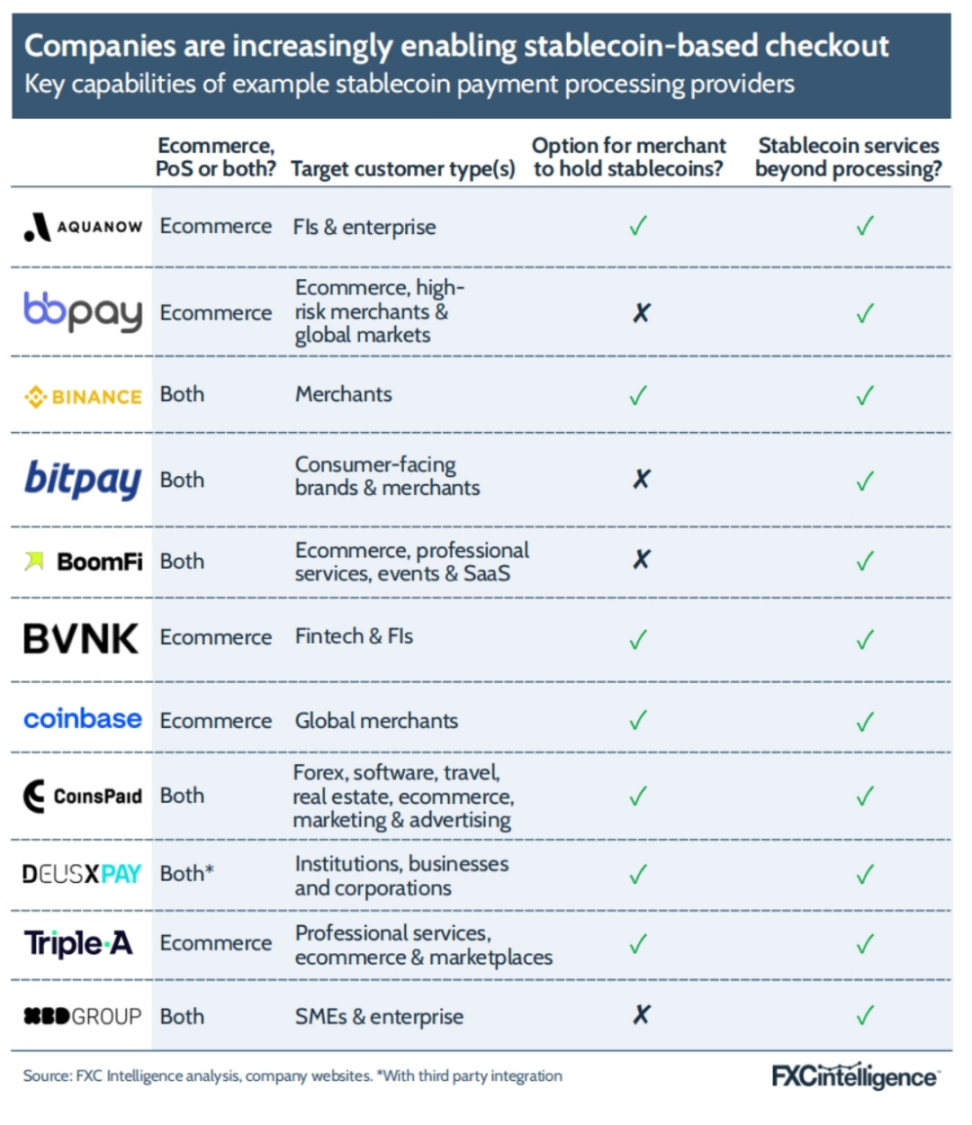
However, like many other stablecoin use cases, this one hasn't seen widespread global demand, and some remain skeptical of its potential. Airwallex's Jack Zhang stated, "I haven't seen mainstream people willing to hold stablecoins unless they can spend them, and currently only Visa and Mastercard have strong enough network effects to issue stablecoin-based cards for spending. I haven't seen widespread adoption of 'spend anywhere.' There may be some closed-ended use cases, but closed channels have existed for twenty years."
6.8 Stablecoin Debit Card
Finally, although stablecoins are seen as an alternative to bank cards, many stablecoin wallets still come with virtual or physical cards, which usually allow users to spend wallet balances directly on e-commerce platforms and offline retailers.
This has spawned a growing market for multi-market card programs, with providers like Bridge, Rain, and StraitsX offering these solutions as part of core product offerings for consumer-facing brands. Currently, these programs serve a diverse clientele: many are institutions offering services around stablecoins, such as account products for individuals or businesses, often with deposit and withdrawal capabilities. At the same time, a growing number of traditional fiat-focused brands are looking to add stablecoin capabilities, and card programs offer a familiar and convenient entry point for users.
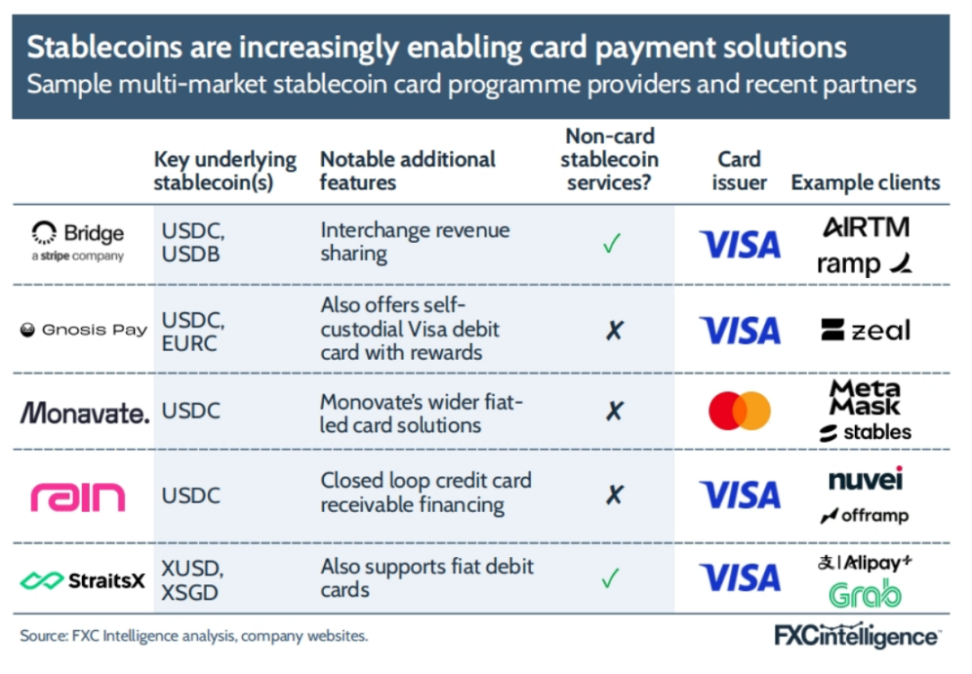
7. Challenges to be overcome in stablecoin payment applications
While we've seen numerous real-world examples of stablecoin payments in the examples above, this is still based on the initial state of the market, with a current supply of $250 billion. Imagine that in the next few years, the supply of stablecoins reaches $2 trillion. What challenges will we need to overcome in this process?
The first and foremost issue is integration or complementarity with traditional payment methods, which brings us back to the question of whether stablecoins offer price and cost advantages. Secondly, the emergence of large-scale payment scenarios requires the question of whether the market has sufficient liquidity to support them. Finally, there's the question of compliance: how can traditional companies address their concerns about entering the stablecoin payment market?
7.1 Price Cost Advantages of Stablecoins
While some claim that stablecoins are inherently cheaper than existing cross-border payment systems, the reality is more complex. Available evidence suggests that stablecoins are currently cheaper in some markets. However, given the current small scale of participants and the continued use of subsidies by some companies to acquire customers, it is unclear whether this cost advantage will persist across all regions as the market develops—or whether further reductions will be achieved with increased scale.
For businesses like consumer-facing Sling Money, the goal remains to keep prices down. "We want to drive down the fees for sending money to near zero and make the process incredibly simple," says Sling Money's Hudack. "Whether you're sitting next to me or 3,000 miles away, I should be able to send you money for free or next to nothing in just a few taps. Stablecoins make that possible: it's a true underlying technological revolution."
However, this goal aligns with that of Wise, a global remittance and payments platform. Wise's CFO, Emmanuel Thomassin, doesn't believe stablecoins can outperform Wise in its key markets. "The reality is that on most routes, sending remittances with stablecoins is still more expensive than using Wise directly," Thomassin stated. "Of course, there may be exceptions for certain currency corridors deemed 'high-risk' by traditional financial institutions. Similarly, in markets facing hyperinflation and persistent currency devaluation, this technology may have advantages."
Stablecoins are great for some markets, but not all; in markets with greater liquidity, the gap is narrowing.
——Chris Harmse, BVNK
Meanwhile, other practitioners see a mixed picture: not all corridors are cheaper, but some stablecoin corridors do offer benefits. OpenPayd's Dimitrova said, "I can't say that all corridors are cheaper all the time. But where we do see an advantage, they are more efficient most of the time."
Our own research confirms this discrepancy. We selected three stablecoin-based providers and compared their bank-to-bank remittance costs for individual clients on major corridors, comparing them with exchange rate quotes from non-stablecoin providers over the same period. We found:
- In many channels, there is indeed a stablecoin solution with a lower average price than non-stablecoins;
- However, not all channels have an average stablecoin price lower than the average non-stablecoin price;
- Only a very small number of channels have an average stablecoin price lower than the average price of the “cheapest non-stablecoin player”;
- Overall, emerging market channels are more likely to see stablecoin prices dominate.
This is also consistent with the observations of white label service providers.
As transaction volumes move on-chain, costs are plummeting. In some exotic markets, where traditional channels remain slow and expensive, stablecoin solutions often rival or even surpass them. Currently, they're nearly on par with ultra-liquid markets like the EUR/USD—not quite on par, but very close.
——Chris Harmse, BVNK
7.2 Composition of Stablecoin Costs
For consumer remittance providers, how they disclose stablecoin fee structures to clients varies widely. Some adopt the pricing model of traditional fiat currency providers, breaking down fees into "exchange rate markup + handling fees." Others break down prices more granularly, directly reflecting the costs of each step in cross-border stablecoin payments.
In short, the cost of cross-border transfer of stablecoins is divided into three parts:
- On-Ramp cost: convert the sending country’s currency into stablecoin;
- On-chain transfer costs: sending stablecoins to the recipient country on the blockchain;
- Off-Ramp cost: converting stablecoins into the recipient’s local currency.
On-chain transfers themselves can be extremely low if the right blockchain is chosen—a primary reason for the claim that "stablecoins are cheaper." However, the real cost burden lies in the "deposit" and "withdrawal" stages. In the past, these two steps were inefficient and expensive, often undermining the hype of "ultra-low costs."
"The last mile must be fast and cheap, ideally instant. But until recently, this step was highly inefficient," explains Conduit's Gertman. The problem is that most companies rely on exchanges for withdrawals. "Exchanges are virtually the only direct way to convert stablecoins into local fiat." Our research has found that exchange fees are often comparable to or even higher than those of traditional remittance providers, hindering the price reduction of stablecoins.
Nowadays, more and more companies are starting to cooperate with local banks to make the deposit/withdrawal process faster, cheaper and more transparent.
"We now connect directly with local banks, providing greater liquidity." Gertman gave an example: Conduit's partnership with Banco Braza allows users to instantly mint BBRL, a stablecoin pegged to the Brazilian real (BRL). This is then converted almost instantly on-chain to a euro-pegged stablecoin. Finally, the euro stablecoin is destroyed, and the euros are transferred directly to the recipient's account. The entire process takes 120 seconds, or two minutes end-to-end.
Instant settlement also eliminates the cost of maintaining a pool of funds, which many believe is the key to achieving low prices.
"Compared to traditional money flows, there are fewer links: the blockchain itself is the ledger, there is no need to maintain a centralized ledger; the client software interacts directly on the chain," said Hudack of Sling Money. But he also admitted that the "last mile" fees of fiat currency channels such as ACH or RTP are "the same as everyone else." "Treat funds as native digital commodities, which in itself brings huge efficiencies."
However, once this low-price strategy becomes popular on the consumer side, Higlobe's Farman-Farmaian believes that there will be a "price war to the end." Higlobe's mission is to "allow global funds to flow instantly and at zero cost." Where will the profits come from? He expects the industry to shift to a service model: instant transfers become "standard," and real revenue comes from value-added services such as loans.
This industry will eventually become like Amazon: instant cash flow becomes a basic service with zero profit, and profits come from other value-added services within the ecosystem.
——Farman-Farmaian, Higlobe
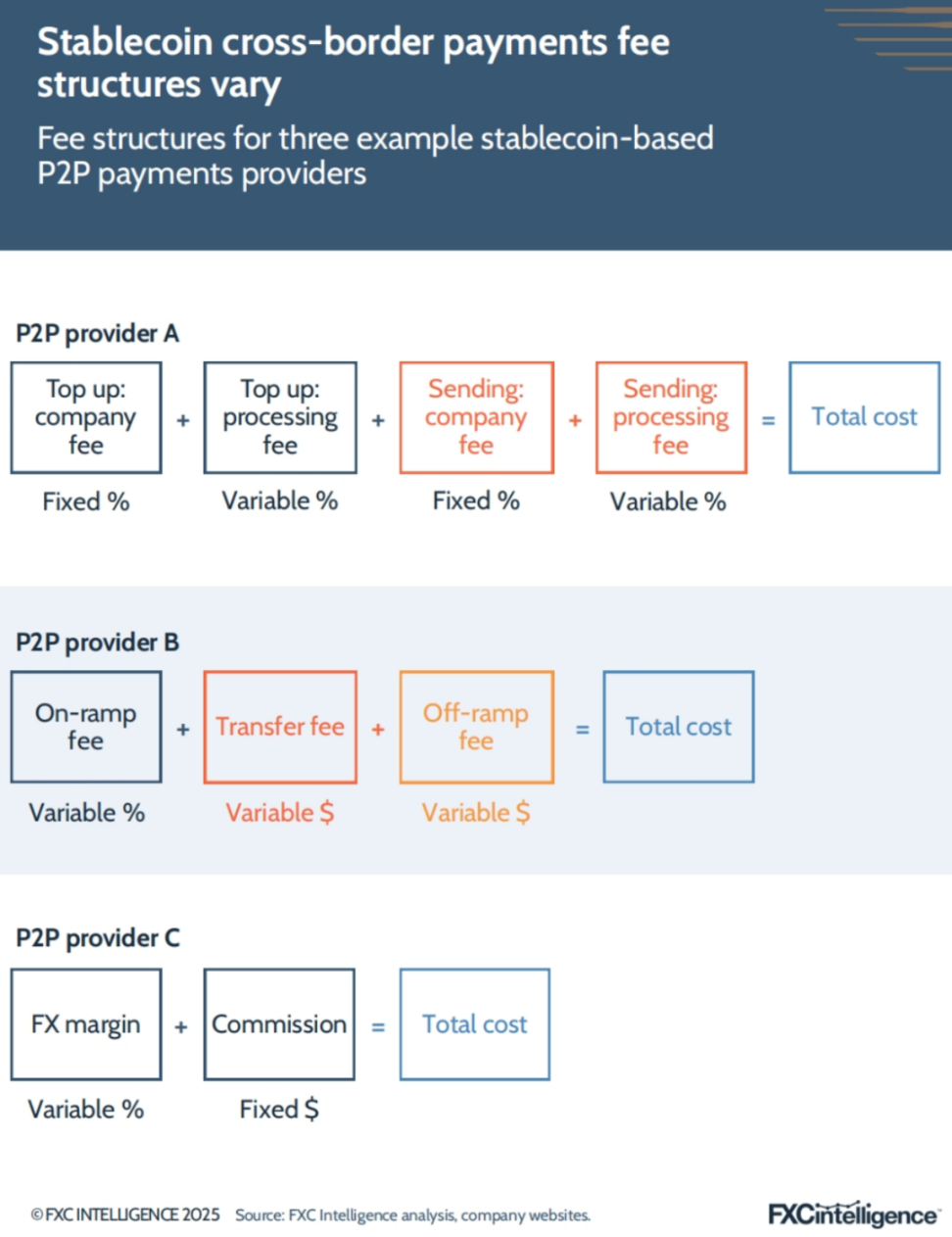
7.3 Liquidity Dilemma
While the industry remains extremely optimistic about the potential of stablecoins, recognized challenges remain. One key issue is sufficient liquidity: ensuring funds can be quickly transferred on and off-chain in target markets. In other words, there must be sufficient demand for stablecoins on the other end, enabling both on-chain and off-chain transfers in the desired markets.
“For every buy order, there has to be a sell order, and vice versa,” Orbital’s Mason noted. “The most liquid currency in the world right now is USDT. If I want to do a $20 million trade in Vietnam, USDT is the only currency with enough depth.”
Insufficient liquidity directly impacts the stablecoins businesses choose for large-value transactions. High-value payments often require only USDT due to the lack of liquidity in other currencies. He added, "Tether has actively addressed this situation in certain scenarios, particularly in areas like commodity trading where capital demand is high, by providing market making and substantial capital for trade financing and other purposes."
Of course, there are still more use cases that require liquidity at a larger scale, but the overall growth of the market is making liquidity gradually available.
The current number of stablecoins in various markets is probably not enough to support companies like Coca-Cola to make treasury-level fund movements.
Liquidity will continue to grow as the next wave of adopters join – especially giants like Glencore, Rio Tinto or Trafigura, who start using stablecoins and naturally drive more liquidity.
—Mike Hudack, Co-founder & CEO, Sling Money
In addition to the entry of large capital movers, a shift in market perception of "stablecoins as US dollar equivalents" is also seen as key to further expansion. "It's crucial to treat dollar-denominated stablecoins as cash in order to stimulate demand for them in these countries and foster a highly liquid foreign exchange market," Circle's Chandhok noted.
7.4 Regulation and Compliance
At the same time, potential challenges remain in terms of regulation and compliance, especially since many core regulatory frameworks are still being developed or have just been implemented. The problem is not so much the regulatory requirements themselves, but the lack of experience and uncertainty of many institutions about how to use stablecoins in compliance with regulations in practice.
“From an adoption perspective, the biggest barrier is, ‘If I’m going to integrate this into my internal systems, how do I reassure my compliance team? How do I identify the receiving wallet? What are the specific obligations under the Travel Rule? How do I monitor transactions?’” Fireblocks’ Shaulov said. “The regulatory guidance hasn’t changed, but the implementation is different, so it’s all about education.”
He cited the Travel Rule as an example: Many jurisdictions require that when a blockchain digital currency transaction exceeds a certain amount,






